
















It’s about more than just weight loss. It’s about reducing your risk for serious conditions like heart disease and diabetes — and regaining the stamina, mobility and confidence to take on every day.


Crouse’s bariatric surgery program offers a dedicated team of physicians and providers, as well as psychological and nutritional counseling — all with the expertise to support you every step of the way.


Begin the process from home by viewing our online informational video. Then consult with our bariatric team via telemedicine visits to start your journey. It’s time — and now easier than ever.

Start today at crouse.org/weightloss or call .









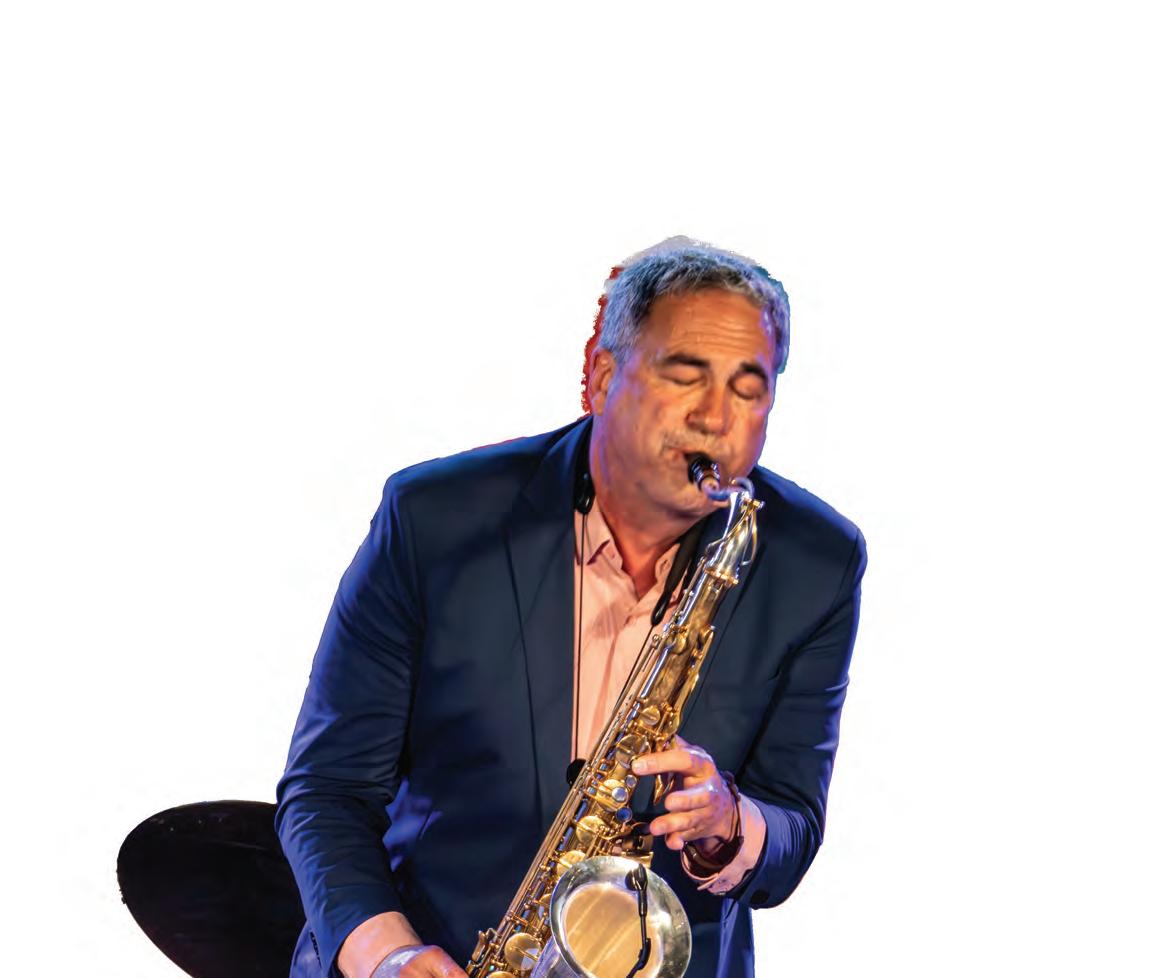
29 Decoration
Try these tips when you update your home
18 Car Buying
Buying a car? Pay your price, not the dealer’s
20 Insurance
To insure a pet can cost you more than $7,000 over the lifespan of a 12-year-old cat or dog. Is it worth it?
22 Volunteer
Bob Stopper: Erie Canalway greeter and ambassador makes a difference in the lives of boaters ... and the community
26 Winter
Winterization: Get your home ready for snow and cold now
32 Renovations
Five expensive renovations homeowners always regret
34 Cover
Saxophonist Bill Tiberio has been teaching at Fairport High School for 36 years
40 Language
Do you have rizz? Understanding today’s slangs. That’s how you’ll be able to talk to your grandkids
42 Gardening
Falling for gardening: Now you can leave that ‘fall cleanup’ of the past and continue planting through the season



Rochester’s oldest financial firm is offering complimentary educational workshops to equip our community with resourceful knowledge and dynamic tools to navigate the complexities of personal finances. Whether you are planning for retirement, already retired, or have concerns about the current or future state of the economy, there is a class for you! Please visit SageRuttyUniversity.com or call 585-512-2333 to learn more.
44 Class Reunion
Members of the Rochester East High School Class of 1964 hold their 60th reunion.
50 Exercise
Coach Kelly Nash teaches that continuing to move will help anyone feel better.
52 Will
Do you really need a digital will?
54 Hearing
Can you hear me now?

A talk with the folks from HLAA-Rochester
58 Aging
Coming to terms with age. By
Jeanne Strining
60 Produce
Winter communitysupported agriculture (CSA) promotes small businesses and healthful eating—all season long
61 Theater
Broadway veteran Tripp Hanson helps breathe life into new theater
66 Dance
Learning modern dance has kept couple moving in retirement
We Erred Because of an error, the story "The Ultimate Road Trip: Route 5 & 20" in the last issue of 55 PLUS was published incorrectly. Half of the story was missing from the issue. To read the complete story, please visit www.roc55.com and type "The Ultimate Road Trip" on the search box. We apologize for the error.

What happens when you move
Investing as a couple
Dining Out
Modern Italian cuisine drawing crowds to Park Avenue restaurant in Rochester
68 Visits
A day trip to Oswego — The Port City is rich in history — and plenty of different foods
72 Addyman’s Corner
A trip to the store
74 Last Page
Duane Pancoast, 85 — Victor author, blogger talks “adaptive gardening” for boomers











By Jim Miller
Do you need to notify Social Security and Medicare if you move to different state?
Yes, if you’re a Social Security and Medicare recipient you definitely need to let these federal agencies know when and where you move so there are no hiccups in your benefits or coverage.
Here’s what you should know.
How to Update Your Info — If you’re receiving Social Security retirement, survivors or disability benefits, it’s required that you notify the Social Security Administration when you move to ensure your deposits continue and you avoid disruptions.
You’ll need to provide them your new mailing address so they can deliver important documents to you like your annual SSA-1099 tax form. And if you’re switching banks or credit unions, you’ll need to update your direct deposit information by providing your new financial institution’s routing number and account number.
If you’re a Medicare beneficiary, they too need your new mailing address so bills, correspondence, your Medicare summary notice and other statements can go to the right address.
You can update both your Social Security and Medicare contact information online by simply using the “My Profile” tab in your personal “my Social Security” account at SSA. gov/myaccount. If you don’t have an account, you can create one online for free in just a few minutes.
Or, if you need some help or don’t have internet access, you can call Social Security at 800-772-1213, or visit your local Social Security office and they will make the changes for you.
Medicare Private Plans — You also need to know that if you’re enrolled in original Medicare, you can move anywhere within the United
States without losing coverage. But if you have Part D prescription drug coverage or a Medicare Advantage plan from a private health insurance company, and you move out of the plan’s service area, you’ll have to switch plans or you’ll face losing coverage.
Part D service areas typically are statewide or can extend to parts of neighboring states, while Medicare Advantage plans’ service areas vary by county.
Moving out of a plan’s service area qualifies you for a special enrollment period (SEP) of at least two months to get a new plan. You may also qualify if you move within your plan’s service area and it offers options different from what you had. The enrollment timing depends on when you notify the plan.
If you tell your plan before you move, your chance to switch plans begins the month before the month you move and continues for two full months after you move. If you tell your plan after you move, your chance to switch plans begins the month you tell your plan, plus two more full months.
To shop for new Part D and Medicare Advantage plans in your new area, use the Medicare Plan Finder tool at Medicare.gov/plan-compare.
You can also switch Part D or Medicare Advantage plans during open enrollment, which runs each year from Oct. 15 to Dec. 7 for coverage starting Jan. 1.
Medigap Plans — If you’re enrolled in original Medicare and have a Medigap supplemental policy you usually don’t have to switch plans if you move, but you do need to notify your provider. Some insurers let you keep the rate based on the state where you originally applied for Medigap. Others may change your premiums to coincide with their coverage in a different zip code.
Editor and Publisher Wagner Dotto
Associate Editor Stefan Yablonski
Writers & Contributors
Deborah J. Sergeant
John Addyman, Mike Costanza
Linda Quinlan, Lucy Lazaroni
Nicole Spector, Kathryne Rakowski
Jeanne Strining
Jane Eggleston, Melody Burri
Columnists
John Addyman, Laurie Haelen
Jim Miller, Jacob Pucci
Advertising
Anne Westcott • 585-421-8109
anneIGHsales@gmail.com
Linda Covington • 585-750-7051 lindalocalnews@gmail.com
Office Manager Allison Lockwood
Layout & Design Angel Campos-Toro
Cover Photo Courtesy of Aaron Winters







By Laurie Haelen

In a perfect world, both halves of a couple share the same investment goals and agree on the best way to try to reach them.
It doesn't always work that way, though; disagreements about money are often a source of friction between couples.
I work with clients every day and have found that one of the greatest challenges in building a successful financial plan is getting couples to work together toward common goals.
The first step is defining what the common goals are and documenting them. Making good investment decisions is difficult if you don't know what you're investing for. That is why it is critical to outline both long-and short-term goals, ideally together.
In some cases, you may have the same goals, but put a different priority on each one or have two different time frames for a specific goal.
For example, your spouse may want to retire as soon as possible,
while you're anxious to accept a new job that means advancement in your career, even if it means staying put or moving later. Coming to a general agreement on what your priorities are and roughly when you hope to achieve each one can greatly simplify the process of deciding how to invest.
Ensuring both spouses or partners know how and why their money is invested in a certain way can help minimize blowback if investment choices don't work out as anticipated. Making sure that both partners understand from the beginning why an investment was chosen, as well as its risks and potential rewards, may help moderate the impulse to say "I told you so" later.
A diversified portfolio should have a place for both conservative and more aggressive investments. Though diversification and asset allocation can't guarantee a profit or protect against a loss, they are ways to manage the type and level of risk you
face — including the risks involved in bickering with your significant other. Aside from attempting to minimize relationship strife, there's another good reason to make sure both partners understand how their money is invested and why. If only one person makes all the decisions — even if that person is the more experienced investor — what if something were to happen to that individual? The other spouse might have to make decisions at a very vulnerable time — decisions that could have long-term consequences.
If you're the less experienced investor, take the responsibility for making sure you have at least a basic understanding of how your resources are invested. If you're suddenly the one responsible for all decisions, you should at least know enough to protect yourself from fraud or work effectively with a financial professional to help manage your money.
If you are the more conservative investor, consider:
• If you're unfamiliar with a specific investment, research it. Though past performance is no guarantee of future returns, understanding how an investment typically has behaved in the past or how it compares to other investment possibilities could give you a better perspective on why your spouse is interested in it.
• Consider whether there are investments that are less aggressive than what your spouse is proposing but that still push you out of your comfort zone and might represent a compromise position.
• Work with a neutral party, such as a certified financial planner, to get the information — such as risk and performance — of investments and see how historically they have impacted the success of financial plans. Looking at it with the best data available may help you see more clearly.
If you are the less conservative investor, consider:
• Listen respectfully to your spouse's concerns. Additional information may increase a spouse's comfort level, but you won't know
what's needed if you automatically dismiss any objections. If you don't have the patience to educate your spouse, a third party who isn't emotionally involved might be better at explaining your point of view.
• Concealing the potential pitfalls of an investment about which you're enthusiastic could make future joint decisions more difficult if your credibility suffers because of a loss. As with most relationship issues, transparency and trust are key.
• A partner who is more cautious than you are may help you remember to assess the risks involved or keep trading costs down by reducing the churn in your portfolio.
• Remember that you can make changes in your portfolio gradually. You might be able to help your spouse get more comfortable with taking on additional risk by spreading the investment out over time rather than investing a lump sum. And if you're an impulsive investor, try not to act until you can consult your partner —just like impulse spending, impulse investing rarely has a good outcome.
The most critical thing in the whole process to remember is that neither partner is necessarily “right.” Only the process of documenting your goals, investing with the appropriate level of risk for the long-term and monitoring the progress of the goals will provide the best chance for success.
There is no guarantee that working with a financial professional will improve investment results, but the presence of a neutral party will likely make it easier for a couple to make decisions. Be sure to understand how an adviser is compensated and whether they are an investment fiduciary who is held to a high standard.
There are many more investments available today than there were many years ago. This is mainly good news for investors but can also be confusing. Understanding what is available, and understanding the concerns of your significant other, is a challenge that is worth embarking upon.


Laurie Haelen, AIF (accredited investment fiduciary), is senior vice president, manager of investment and financial planning solutions, CNB Wealth Management, Canandaigua National Bank & Trust Company. She can be reached at 585-419-0670, ext. 41970 or by email at lhaelen@cnbank.com.





By Jacob Pucci

It’s around 4:30 p.m. on a late Saturday afternoon, yet guests are already lining up for dinner. They’re not after an early bird special, but rather a seat at Vern’s, a quaint spot in Rochester’s lively Park Avenue neighborhood whose noreservations policy means if you want a taste of wonderfully creative, modern Italian food, you'd better get there early. Vern’s inspired take on modern Italian cuisine has been drawing crowds since the Swan family, a sibling team of prominent Rochester restaurateurs whose other operations include fellow Park Avenue hot spots Dorado and Roux, opened the restaurant in 2019.
We were able to skip the 30-minute wait for an indoor table by sitting at the marble-topped bar that serves as the centerpiece of the small dining room. The drink list includes five regional beers on tap, a thoughtfully chosen list of low-intervention (or natural) wines and ciders from around the world and a cocktail list of about a dozen offerings, including an option to “wing it” and leave it in the bartenders’ capable hands.
Dinner began with the caprese salad ($14), a daily special of heirloom tomatoes tossed in a hot honey vinaigrette and topped with fresh mozzarella cheese, fresh mint, balsamic vinegar, arugula pesto and flaky salt. The tomatoes, firm-fleshed and flavorful, were a quintessential taste of summer. The mint and pesto offered a twist from the usual basil, but the bright flavors and vibrant green colors were perfectly at home. My only wish is that I had some crusty bread to sop up the vinaigrette — acidic, with a bit of sweetness and a pleasant tingle of spice — left behind in the bowl.
The food menu is short — about a dozen small plates, salads and starters; two pastas; a risotto dish and five wood-fired pizzas, plus a steak that’s grilled over rosemary branches and another wood-grilled meat, vegetable or seafood option that changes regularly. But considering the size of the open kitchen, which one might euphemistically call intimate, it’s impressive that the crew is able to produce the variety they do.
Wanting to sample both the pasta and pizza, we ordered the yellow pizza ($18) and that day’s fettuccine ($28). The pizza gets its name from the charred corn cream that serves as the base, which is topped with smoked mozzarella cheese, Calabrian chilies, salsa verde and crumbled ricotta salata cheese.
The first time I had sweet corn on pizza was during a late-night Domino’s order while studying abroad during college in Europe, where apparently corn and sliced hot dogs are popular pizza toppings. As one might surmise, my memory of said pizza is a bit hazy, but suffice it to say, it didn’t hold a candle to Vern’s pizza, which
like the caprese salad that started our meal, provided a familiar taste of summer in a reimagined form.
The charred corn and smoked mozzarella provided a smoky flavor that was more subtle than I expected, and while I could have handled an extra punch of smoke, the balance did allow the heat from the Calabrian chilies and herbaceous salsa verde to shine through.
Of course, all that would be for naught if the crust was subpar. A poor crust will doom even the best toppings. Luckily, that was not the case here. Evenly round, with a light chew that’s characteristic of a properly made dough, every part of this pizza did justice to the others.
The Neapolitan-style pizzas are about 12 inches in diameter and truthfully, two diners could split a salad and a pizza and squeak out just enough room for dessert. But that would mean omitting the pasta, which would be a travesty. The Lost Meatball Ragu, which includes shellbow pasta tossed in meaty tomato sauce and topped with a large dollop of ricotta cheese, grated parmesan and a drizzle of olive oil, is a more classic offering that’s a fixture on the restaurant’s everchanging menu. But once again feeling the pull of the season, we opted for the fettuccine, tossed in a light but creamy sauce of crab, mascarpone cheese, lemon, chilies and fresh tarragon, garnished with fried zucchini, chives and lemon zest.
All dishes at Vern’s are meant for sharing, further evidenced by the pair of metal tongs served with the bowl of pasta, though any selfishness is justified, because it’s just that good. In this case, the combination of the mascarpone, a creamy cheese with a


bit of tang, was a perfect pairing with the lemon, creating a dish that was simultaneously rich, yet light. Rather than being the star of the dish, the crab played a supporting role, bringing a briny flavor and subtle sweetness that nicely complimented the rest of the sauce.
We closed things out with a slice of summer fruit and poppyseed olive oil cake ($12). Baked with in-season plums and nectarines that cooked down into a jammy sweetness, the cake was moist, with bright flavors of olive oil. What looked like ice cream on top was actually vanilla mascarpone cheese, the black speckles mixed throughout an indication of real vanilla bean.
Whether it’s the tightly curated bar selection or the bottles of wine and prepped ingredients poking out from a window looking into the open kitchen, nothing is superfluous or goes to waste at Vern’s.
Every detail is accounted for and intentionally executed. Take the nonalcoholic cocktails, for example. At $7 each — half the cost of the regular selections — these lower-priced options could be an afterthought. But at Vern’s, the espresso for the espresso tonic cocktail is freshly pulled and the orange juice for the “phony” negroni is juiced at the bar to order, creating a frothy juice they like to call “fluffy.”
The menu changes multiple times each season, meaning that any menu and individual visit is a snapshot of time that will soon be obsolete. But that’s OK, because even as the dishes change, the commitment to quality and attention to detail does not. Just as for the cocktails, you can let the team at Vern’s wing it. You’ll be in safe hands.

696 Park Ave. Rochester, NY, 14607
585-340-6689
www.iloveverns.com/ www.facebook.com/vernsrochester www.instagram.com/iloveverns/
Sunday to Thursday, from 4 – 9 p.m.; Saturday and Sunday, from 4 – 10 p.m. Bar remains open for at least one hour after dinner service.
There are characteristics that set some skilled nursing facilities apart from others. When the quality of the service and the resident are the focus of everything the facility does, it can be noticed almost from the minute the front door opens.

Aaron Manor Rehab. & Continuing Care Fairport NY | 585-377-4000
Absolut Care of Aurora Park East Aurora, NY | 716-652-1560
Absolut Center Endicott, NY | 607-754-2705
Absolut Care of Three Rivers, LLC Painted Post NY | 607-936-4108
Absolut Care of Westfield, LLC Westfield NY | 716-326-4646
Absolut Care at Gasport Gasport NY | 716-326-4646
Absolut Care of Allegany Allegany NY | 716-373-2238
Autumn View Health Care Facility Hamburg, NY | 716-648-2450
Avon Nursing Home Avon, NY | 585-226-2225
Brookhaven Health Care Facility LLC East Patchogue | 631-447-8800
Chautauqua Nursing and Rehab Dunkirk NY | 716-336-6400
Conesus Lake Nursing Home Livonia NY | 585-346-3001
Crest Manor Living & Rehab Ctr. Fairport, NY | 585-223-3633
East Side Nursing Home Warsaw, NY | 585-7868151
Elderwood at Amherst Buffalo, NY | 716-835-2543
Elderwood at Cheektowaga Buffalo, NY | 716-681-9480

Elderwood at Grand Island Buffalo, NY | 716-773-5900
Elderwood at Hamburg Buffalo, NY | 716-649-7676
Elderwood at Lancaster Buffalo, NY | 716-683-6165
Elderwood at Liverpool Buffalo, NY | 315-457-9946
Elderwood at North Creek North Creek, NY | 518-251-2447
Elderwood at Ticonderoga Ticonderoga, NY | 518-585-6771
Elderwood at Waverly Buffalo, NY | 607-565-2861
Elderwood at Wheatfield Buffalo, NY | 716-215-8000
Elderwood at Williamsville Buffalo, NY | 716-689-6681
Elderwood of Uihlein at Lake Placid Lake Placid, NY | 518-523-2464
Episcopal Church Home Rochester, NY | 585-546-8400
Friendly Home Rochester, NY | 585-381-1600
Garden Gate HCF Cheektowaga, NY | 716-668-8100
Hamilton Manor Nursing Home Rochester, NY | 585-225-0450
Harris Hill Nursing Facility Williamsville, NY | 716-632-3700
Hudson Valley Rehab & Extended Care Facility Highland, NY | 845-691-7201
Jewish Senior Life Rochester, NY | 585-427-7760
Kirkhaven Rochester, NY | 585-461-1991
Latta Road Nursing Home East Rochester, NY | 585-225-0920
Latta Road Nursing Home West Rochester, NY | 585-225-0910
Loretto Health and Rehabilitation Syracuse, NY | 315-413-3200
M.M. Ewing Continuing Care Center Canandaigua, NY | 585-396-6040
Maplewood Nursing Home Webster, NY | 585-872-1800
Morningstar Care Center, Inc Oswego, NY | 315-342-4790
Newark Manor Nursing Home Newark, NY | 315-331-4690
Niagara Luthern Health System Lancaster, NY | 716-684-0202
North Gate Health Care Facility North Tonawanda, NY | 716-694-7700
Penfield Place Penfield, NY | 585-586-7433
Roscoe Rehabilitation and Nursing Center Roscoe, NY | 607-498-4121
Seneca Health Care Center West Seneca, NY | 716-828-0500
Seneca Nursing & Rehab Waterloo, NY | 315-539-9202
Saint Johnsville Rehab & Nursing Saint Johnsville | 518-568-5037
St. Ann’s Communities Rochester | 585-697-6000
St. John’s Home Rochester | 585-760-1300
Sunset Nursing Home, Inc Boonville | 315-942-4301
Susquehanna Nursing and Rehab Johnson City | 607-729-9206
Taconic Rehab and Nursing At Beacon Beacon | 845-440-1600
Taconic Rehab and Nursing At Hopewell Fishkill | 845-896-1500
Taconic Rehab and Nursing At Ulster Highland | 845-691-6800
The Brightonian Nursing Home Rochester | 585-271-8700
The Highlands at Brighton Rochester | 585-442-7960
The Hurlbut Rochester | 585-424-4770
The Nottingham RHCF Jamesville | 315-445-9242
Waterville Residential Care Center Waterville | 315-841-4156
Woodside Manor Rochester | 585-461-0370

Shop near and far, compile competing offers — and always be willing to walk away
By Lucy Lazarony
Looking for ways to save money on your next car purchase? It is easy to see why. According to Cox Automotive, the average price of a new car in 2024 is $48,155, an increase of 15.5% since March 2021. That is a lot of money to spend but there are things you can do to lower the price of the car you have your eye on. Here are 10 smart car buying tips from the experts.
1. Do plenty of research. Finding the right car for your family's needs takes some time and some research.
"First, think about the kind of car that will best fit your needs both now and in the future — small SUV, pickup
truck or sedan? —then research the various models in each class to decide which could be best for you," says Matt Degen, senior editor for Kelley Blue Book, the vehicle valuation firm.
Don't just stick to just one brand or model. Research several.
"Research various makes and models. Take test drives to make sure a car is a good fit for you," advises Tom McParland who runs Automatch Consulting.
2. Set a budget. Take some time to peruse your finances and determine how much you can afford to spend on a car.
"It's also crucial to set a budget at the beginning of your shopping
process. This should factor in not just the cost of the vehicle and monthly payments, but associated expenditures that will go with it, such as insurance and fuel. Check the Kelley Blue Book fair purchase price, (and) know how much you should pay for the vehicle, right down to your ZIP code, as well as the five-year cost to own figure for the bigger picture on expenditures over the years," Degen says.
Use loan calculators to help determine how much a monthly payment would be.
"Know your budget," McParland says. "The best way not to get ripped off is to have an honest understanding of what you can really afford. Use loan calculators to work backwards from a

The average price of a new car in 2024
is $48,155,
according to Cox Automotive, a company that designs software for automotive dealers and consumers
via phone and email," McParland advises. "Do not negotiate in person. Request itemized out-the-door prices on cars you are interested in. If the dealer doesn't provide them, move on."
5. Shop around for financing. Obtaining a lower interest rate can save you significant money over the years.
"Remember that you shouldn't just shop for the best deal on a car; you should shop for the best deal on financing, too," Degen says. "See what financing terms and interest rates your bank or credit union offers and be sure to search for current deals from automakers. Getting pre-approved for a loan from your bank also gives you more power to negotiate at the dealership."
6. Get good value for your trade-in. Now is a good time to trade in or sell your used car.
than ever, it is easier to buy a car from a dealer in a different city or even different state.
"Yes, you'll have to arrange for the vehicle to be transported to you, but if you zero in on the exact car you want at a price you like, this route can be worth it."
9. Shop certified pre-owned cars. One way to pay less on your next car purchase is to search a dealer's inventory of certified preowned cars.
"Certified pre-owned models are used cars that are backed by a factory warranty and have been combed over by mechanics to make sure everything is in working order," Degen says.
target monthly payment to a total cost. Focus on vehicles that are at or below that total, and don't forget to buffer for your local sales tax and DMV fees."
3. Make dealers compete for your business. Shop several dealerships, not just one or two.
"The only way to know if you are getting a good deal on a new car purchase is by making dealers compete," says Mike Rumple, founder of Yourcarbuyingadvocate.com in Warren, Ohio. "This means you need to reach out to multiple dealers on the same vehicles with the same MSRPs (manufacturer's suggested retail prices) and get proposals or buyer's orders to compare deals.
"If you go to only one dealership you'll never know if you've gotten a good deal or not. This is the only way to ensure you are getting the best possible deal."
4. Negotiate by phone or email. There's no need to negotiate with a car dealer in person if you don't want to.
"Conduct all of your negotiations
"Although the market is starting to 'normalize' relative to the car-buying frenzy of the past few years, used car values are still elevated, so your tradein vehicle may still be worth more than you expected. Shop your vehicle around, including using appraisal tools like this one from Edmunds," says Joseph Yoon, consumer insights analyst at Edmunds.
7. Make supply your best friend. Save money by choosing a car with a big inventory.
"Sometimes, it's as simple as that concept you learned back in Econ 101: supply and demand. The larger the supply of vehicles, the better your deal might be. Starting your search online should give you a good idea of the brands carrying greater inventory. Dealers with higher volumes of inventory for a specific model might be more willing to incentivize or negotiate on a better deal," Yoon says.
8. Shop beyond your local area. The car you are looking for with a great price may be in a different city or state.
"Whether you want a particular car with specific features or you're just not finding a great deal for the vehicle you want in your area, expand your search," Degen says. "Now, more
"Buying a CPO car that is just two or three years old will still get you the latest tech and safety features but can save you many thousands of dollars versus buying new. This method lets you avoid the initial and significant depreciation that comes with a new car."
10. Consider leasing an electric vehicle. If you have ever thought about an electric car, now is a good time to shop.
"Demand for new electric vehicles has plateaued, and automakers are eager to help dealers make deals with shoppers via massive discounts and other incentives," Yoon said.
When leasing, he added, buyers can take advantage of the full $7,500 electric vehicle (EV) IRS tax credit without worrying about rules regarding your household income or where the vehicle was made. But as always with EV consideration, make sure it's a fit for your lifestyle with respect to charging and range," Yoon says.
Lucy Lazarony is a freelance journalist living in South Florida who writes about personal finances, the arts and nonprofits. Her writing Is featured on Next Avenue, Bankrate.com, MoneyRates.com, MSN.com and the National Endowment for Financial Education. This article was previously published online at www.nextavenue. org. Reprinted with permission.
To insure a pet can cost you more than $7,000 over the lifespan of a 12-year-old cat or dog
By Deborah Jeanne Sergeant
You love your little furry pal. But is purchasing a pet insurance policy a good investment?
Emotional aspects aside, pet insurance can cost between $20 and $50 a month. That can add up to $600 annually and $7,200 over the lifespan of a 12-year-old cat or dog.


“If the retirement income is sufficient, then it’s important to know if the insurance is going to cover all medical procedures and medications, or if not, what are the additional costs,” said Diana Apostolova, investment consultant with Rochester Investments. “For some people, a pet maybe their only companion, but it will be nice to





see if low-income retirees can get some kind of external support towards pet bills.”
Pet owners should also realize that pet insurance works differently than insurance for humans.
Jeff Feldman, Ph.D., and certified financial planner with Rochester Financial Services in Pittsford, pointed

out that insurance for people is somewhat subsidized. Procedures that cost hundreds of thousands of dollars result in bills of a few thousand dollars for co-pays and deductibles.
“For a pet, it’s more like dental insurance,” Feldman said. “It’s all figured out by insurance companies and there’s no subsidizing. You’re
paying for what you’re getting.”
Many plans cover a percentage of preventive care and catastrophic care; however, it may pay to self-insure. MetLife pet insurance estimates that the cost of emergency vet visits for dogs range from $150 to $5,000 and cats from $150 to $3,000. But the chances that your dog or cat would need a costly vet visit are fairly low.
“If you can’t self-insure and you don’t want to be faced with that decision when faced with a $1,500 cost, maybe pet insurance is for you,” Feldman said. “If there’s a free wellness check, it’s likely factored in.”
The type of pet you have also matters. Phil Provenzano, certified Social Security specialist with The Financial Guys in Rochester, said that some breeds are prone to health issues, like German shepherds tend to be prone to canine hip dysplasia. Among pugs, health issues such as brachycephalic obstructive airway syndrome and eye ulcers are more common. Owners of these beloved breeds may see a vet more often than other breeds.
“For pets with a history of health

SATURDAY
November 2nd 11AM - 6PM
SUNDAY
November 3rd, 11AM - 3PM 2 days this year instead of three!
problems, insurance might provide peace of mind,” Provenzano said. “If you’re in a position where you can afford unexpected veterinary bills, you might decide insurance isn’t necessary. However, if a large vet bill would be a financial strain, insurance can help mitigate that risk.”
Look the plans over as to their terms of coverage, deductibles and reimbursement rates.
“It’s important to compare different plans and understand what’s covered, including any exclusions or limits,” Provenzano said.
Plans that include preventive care—if you plan to have your pet receive regular check-ups, dental care and vaccines—may help mitigate the expense of the premiums.
“For some, the peace of mind and financial protection offered by insurance are worth the cost, while for others, it might not provide enough benefit,” Provenzano said. “Ultimately, it’s a personal decision that depends on your pet’s needs, your financial situation, and how much value you place on the security that insurance provides.”

Jared Chase, Music Director
Oct 21 “A New Beginning” Dec 16 “Holiday Classics”
Feb 10 “Nordic Landscapes” May 5 “From Beethoven to Mahler!” www.PenfieldSymphony.org (585) 872-0774
Getyourticketsnow! Concert Tickets Each General Admission $15 Students with ID $1 Season (4concerts) $45 Groupratesavailable
Tickets
Online: www.PenfieldSymphony.org
By Phone: (585) 872-0774
By Mail: 1587 Jackson Rd, Penfield NY 14526
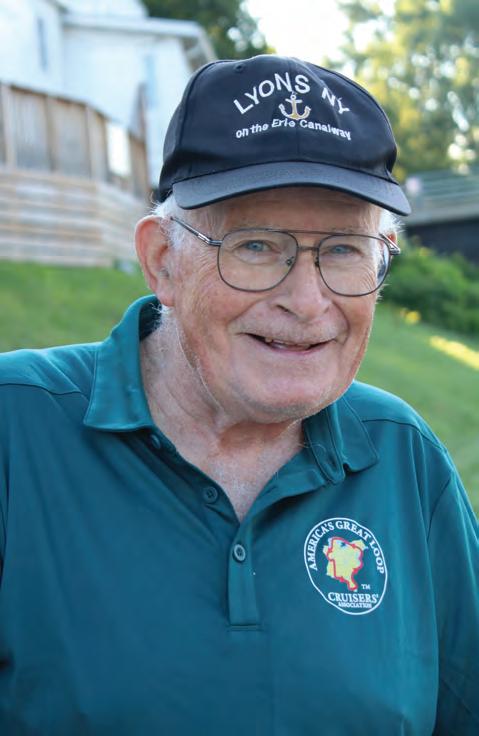

Erie Canalway greeter and ambassador makes a difference in the lives of boaters ... and the community
By John Addyman
It was 7:30 on the last morning of the four-day Peppermint Days celebration in Lyons, a village festival that’s been going on for 33 years.
There were just a few cars moving. A pickleball tournament had taken over one street. Vendors were just getting ready for the day, a fried dough truck one of them.
On the canal, the water was placid and quiet. Four boats had docked and spent the night. The “Nauticlue” was one of the bigger ones and people were stirring inside.
The sun hadn’t hit the water yet;
this part of the canal was shadowed by the fire hall above. The air was cool with condensation covering the tables along the port area.
And down a long deep ramp, Bob Stopper, nursing a bad knee, worked his way slowly toward the docked boats.
Stopper, 84, is an official “Erie Canalway greeter and ambassador,” one of eight retired folks in Lyons who share the job.
That means he, or one of his colleagues, is there at the Lyons dock to welcome boats that have pulled in for the night while they navigate this
part of the Erie Canal. And those boats come from all over the United State and other countries.
Last year, Lyons welcomed 325350 boats that stopped for the night. Those boaters shopped in Lyons or grabbed a meal or went to the movies at the historic (and inexpensive) Ohmann Theater or took a bike ride on the Erie trail or toured the village’s historic landmarks.
And Stopper was there to welcome them, something he’s been doing for 15 years after retiring as an English teacher at Newark, a job he’d held for 34 years and an adjunct English and public speaking professor at Finger Lakes Community College, where he’d been for 16 years.
It’s easy to underestimate what he does.
But he and the other greeters do a lot more than say “Hi.”
“I take a lot of pictures,” he explained. “One of the things I do if they’re going through locks at 8:30-9 a.m., I will be there to take pictures of them exiting the lock. They love it because most boaters have very few if any pictures of themselves on their own boat in action.
“I text them immediately or email them. If the boats are coming out of the


lock, you’ll see Lock “27” in the photo background. They love that because it automatically identifies who they are, where they are on the canal, what they were doing, what time of the day. They can figure that out by the shadows. That has gone over extremely well. We don’t charge for that. I just happen to do it. It’s good promo and good publicity.
“The camaraderie that results is just out of this world. In all the years I’ve been doing this, I’ve never seen a boater I didn’t like. They’re so appreciative of what we do.”
The greeters are all senior citizens, all participate in at least three community volunteer organizations and all love what they do.
“And people are so appreciative. They tell us, ‘I can’t believe you’re doing this. Oh my, you’re not being paid! You’re not an elected official…’”
On this Saturday morning, Stopper approached the line of boats, waving through the plastic shades at people who were just stirring. He headed for the boat “Scandia” out of Java. Craig Erickson and Don Phillips of Brockport were aboard and sitting in their cabin.
Stopper knew them. He said “Good morning” and showed them what he’d brought for them — fresh
MIDDLE: Bob Stopper does his thing, surprising Brockport sailors Craig Erickson and Don Phillips with still-warm fried dough from one of the Peppermint Days vendors.
RIGHT: The Erie Canal (and other watercourses), runs from Newark to Clyde.
funnel cakes in a paper bag, purchased on his walk.
In turn, Phillips offered him some blueberry pancakes. They were canal friends, people who had been through Lyons many times before. Stopper has a long list of them.
“They are the nicest people,” Stopper said. “They have beautiful stories to tell.
“People are fascinated because we don’t just say ‘hello’ and ‘welcome.’ If you need a ride someplace, we usually provide that, like an emergency ride to the local airport. Emergency rides to the mall in Waterloo. We frequently help people, if they’re handicapped, help them get their groceries in Aldi’s or elsewhere. We’ll bring the groceries back to their boat. We frequently take people for parts if they need them, parts for their boats. And, of course, and I think that’s the big thing, we really go out of our way to help the entire community, not just one business but everybody.
“What has happened, with our greeters, several of us get a phone call a couple of days in advance of somebody coming through on their boat. That’s just a special thing on this little canal, for people who are traveling from around the world or other states
intending to stop just to see me or one of the other greeters. It’s an emotional sort of thing.”
How did all this greeting get started?
“I was an avid fisherman and became involved in taking pictures while I was fishing on the canal,” Stopper explained. “Jack McCrannels and I were standing at the canal bank in 2009 and a sailboat came through. The people asked us, ‘Where the hell is Lyons, New York?’
“We started laughing and said, ‘You’re in Lyons.’
“The lady said, ‘Please, we’re looking at the map and it says you’re at the next lock somewhere.’” Stopper then added, “That book still says Lyons is at Lock 28A not Lock 27.
That's the Canal Corporation Tourist Guide — and it’s not the only one that’s incorrect.
“From that point on — Jack and I looked at each other and said, ‘We’ve got to do something,’” he said. “Jerry Ashley from the Main Street Program got involved. We put together a little map and we started welcoming people and taking them around town.
“In 2010, I received a call from John Callahan, deputy director of the Canal Corporation. He said he had noticed I

had published some articles on Wayne County life and taken a lot of pictures and could they interest me in helping to promote the canal more?”
The rest is history.
Weekend fun on the Erie Canal
Stopper quickly went beyond the expanded welcome the greeters provided.
In 2017, he and Keith Bridger of the Rotary Club put together a special tour of the Erie and Seneca-Cayuga canals, starting at Bob Stivers’ marina near the Canal Park on Seneca Lake.
“Our goal was to get people out on the Erie Canal. We called it the weekend fun on the Erie,” Stopper said. “We charter Bob’s 50-passenger pontoon boat. We come from his marina to Lyons and it’s about a five-hour trip. Along the way people get breakfast on the boat and a bag lunch. I narrate the entire tour. It’s very historical. We also take them to
the Montezuma aqueduct, which is probably the most photographed place on the Erie Canal. We usually stop and let people take some pictures if they wish. We come back through Clyde into Lyons, Seneca-Cayuga Canal, then get on the Erie Canal.
“Then we give a local tour, another 2 ½ hours, on Saturday afternoon. We come as far as the dry docks and we keep the boat for the weekend. We’re doing it just two days this year. The big trip costs $85, the afternoon trip is $25.
“Sunday, we take the boat back, the same trip in reverse. There’s a cash bar, a lavatory on board, a couple of surprises and anything else we can come up with. We usually have a special prize — bottle of Tugboat Red wine from Lucas Vineyards — for the oldest person on board or the person who has come the greatest distance. The big thing is the last seven years we’ve sold out, even when we were running it four days on a weekend.”
He feels most of the people who
take the longer trip are interested in all the history the tour highlights.
“For the people who select the shorter trip, it’s more of an experience,” he said. “We have a fantastic relationship with Newark and Clyde. We call each other as greeters and tell them ‘This boat is coming through, these bikers are coming through.’ We meet bikers, too, but not to the same extent that we meet boaters.”
Stopper said that the greeters have no set hours.
“Basically from 5 p.m. on, we always try to be at the dock. All of us, if we’re traveling over the bridge or in the area during the day, if we see that a boat has arrived, no matter who we are, whether it’s our night or not, we’ll go down to say ‘hello’ to them.
“And we have kind of a rule of thumb: If people are in a sailboat, they’re looking for water and fresh fruit; if it’s a powerboat, they’re looking for a martini and a steak. What we’re also finding more and more,

the first thing people ask is ‘Where is your history?’ They’re looking for history not only of the canal, but of the community. That history is frequently buried on back streets or in buildings that have been torn down.”
At the Lyons dock, there are large posters listing historic sites in the village and environs. The greeters hand out brochures about the history of the Erie Canalway and a large map of 100 miles of the Erie Canal from Medina to Clyde.
Greeters also take some other steps. “When people arrive, we ask why they stopped. If a marina somewhere has recommended us, I take a picture of the boat and I send it to the marina and say, ‘Thanks for recommending us. They arrived safely.’
“I do the same thing with the great loop boats that come through, I take a picture and send it to the director, Kim Russo, and say they’ve arrived and say they know you. She always responds. I think it’s the kind of quiet
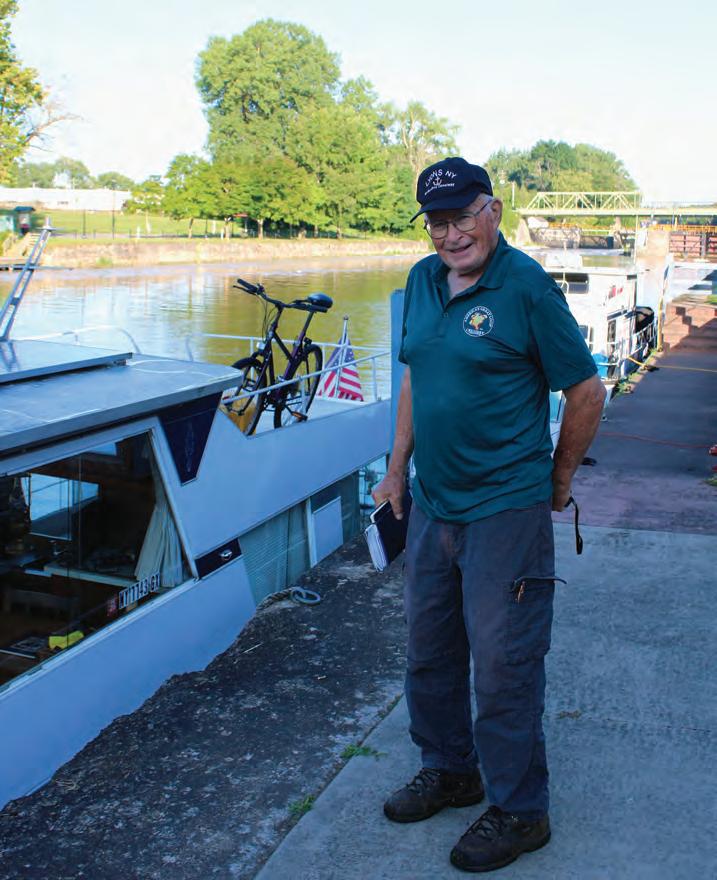
communications we do. I think it’s working for us very, very well.”
The great loop boats are making a 6,000-mile cruise through the Eric Canal and Great Lakes, down through Illinois, Missouri, Tennessee, Alabama, Florida, then up the Atlantic coast to the Hudson River and New England and St. Lawrence Seaway.
Last year, 44 looper boats stopped in Lyons. “That’s extremely good for our community,” Stopper said. “I knew half of them.
“For many of the loopers, this is the teaspoon of their bucket list. Some of them are well-to-do, but some have really scraped to make the journey possible. You can spend 10 minutes with them or three hours. That’s how interesting it is to talk to these people.”
Stopper’s big heart provided a moment that he’ll never forget and has helped cement the kindness and care legend of the Lyons canal port welcome.
“I went down to the dock one
morning eight years ago. I asked the gentleman in one boat, ‘Is everything OK?’ He said his wife was a little emotional this morning. They had been out at sea for a long time. They had just found they were going to be grandparents. Their daughter had had two previous miscarriages. This time she was five months pregnant and she figured she was at a safe point and had just told Mom and Dad. Mom was beyond herself. So I called John Albanase, the lock tender. I said, ‘Pick some flowers that you have outside.’
“I have a picture of that, of him handing the flowers to that lady. Fastforward eight years and we’re still getting Christmas cards from them… ’Here’s our daughter…here’s our grandson…here’s grandson number two…here’s grandson number three — we’ll never forget you.’ We make a difference. That’s the biggest thing. There’s no doubt in my mind, we make a difference. That’s what we’re here for, to help each other as much as we can.”

By Deborah Jeanne Sergeant
Your fuzzy sweaters may be in storage for a while, but it’s time to get those home repairs scheduled.
Contractors appreciate timing jobs for when the weather is nice. It’s also helpful for them for planning their work rather than receiving dozens of “emergency” calls once the snow flies. Especially pertinent are winterization tasks to keep your home energy efficient and cozy for the season.
Sabrina Harris, owner of Handyman Home Care in Rochester, encourages homeowners to have their furnace checked.
“You should have that, and your hot water heater tank checked yearly,” Harris said.
By having these appliances looked at, your hot water heater and furnace will run more efficiently, saving you energy. According to www.energystar. gov, the average household spends $2,000 on energy with about half of that going toward heating and cooling costs.
Are your gutters clear? Or even in place? Clearing, repairing and replacing gutters and downspouts will keep the melting snow from pooling near your home’s foundation this winter.
“That’s so important,” Harris said. “You need to have covers on them to keep leaves out.”
Your home can feel drafty for many reasons. Harris encourages
homeowners to “fix your roof. Replace any rotten wood. Insulate and get new windows and doors—those are two other ways to keep the drafts down.” According to www.energystar. gov, a well-insulated home without air leaks can save homeowners 10% on their energy bills. Insulating homes doesn’t mean tearing up your house. Mike Caldarelli, owner of Mike's Home Repair Services in Rochester, said that his company can blow insulation into walls, using a minimally invasive system. Replacement windows can reduce drafts. They start at about $150 and can save you about 12% on your energy bills.
“If there’s damage to the window
frames it would have to be repaired,” Caldarelli said. “It could take one to two days to replace all the windows in a home, depending on the size of the home.”
In addition to preventing water damage, replacing or repairing the roof can keep your home better insulated. And there’s no time like the present to have roof work done.
“You can’t do it in the winter because the shingles don’t seal then,” Caldarelli said.
If you have deck damage, repairing it now can save you more costly repair later. Resealing now can prevent water from seeping into the wood during the freeze-thaw cycles of winter.
Even though weeks of sunny days stretch before us, consider the winterization projects you should have completed before the snow flies.
“It can take a few weeks to start if I’ve been busy,” Caldarelli said.
A few DIY projects and strategies can help your home stay warmer this winter— no handyman skills or tools required.
• Just before it turns cold, seal windows on the inside with plastic. The budget-friendly kits are readily available at hardware or general merchandise stores and are easy to install.
• Test areas around windows and doors to find air leaks by having someone else inside feel for air as you blast it from the outside with a can of compressed air (look for it among office supplies). Caulk around window and doorframes. Buy a few draft blockers. Some are rubbery and permanently installed for frequently used doors. For seldom used doors, the stuffed type provides a decorative touch.
• Close off spare bedrooms and close the vents so you’re not heating space no one uses regularly.
• Clean your heat vents before you turn on your furnace.
• Set ceiling fans to clockwise mode to push warm air down.










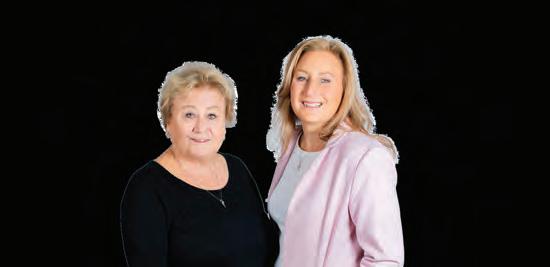
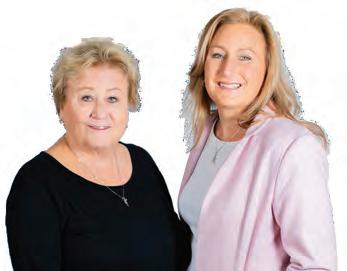








By Deborah Jeanne Sergeant
If your home is swathed in minimalistic gray or (shudder) still boasts the Tuscan theme, it’s a great time to freshen up your home.
The quarantine period of the pandemic caused a lot of people to take a frank look at their homes. Now that home centers have supplies in stock, why not renovate?
To avoid a dated look, Julie Ann Shahin, owner of Julie Ann Rachelle Interiors, LLC in Rochester, said that the first step is to assess what you have. There’s no need to chuck all of your home furnishings—in fact, it’s a mistake to do so.
“It’s like making dinner,” she said. “You have some ingredients already on hand.”
Keep anything that holds significant sentimental value and is good quality, yet don’t be afraid to use things and alter things in ways
that make sense for you, such as repurposing or painting furniture.
“I love when people refinish tables or wood to a lighter finish,” Shahin said. “Or you can paint to match your color palette. If you’re not a huge lover of wood, make sure it comes in as an accent somewhere.”
She likes mixing modern and vintage, such as an antique mahogany dining table under a modern, minimalist chandelier to balance the look.
“You’d want to add a modern centerpiece and contemporary tableware to complete the look,” she added. “Your overall vision for your space should stay in your mind. Keep your precious antiques and focus on combining old and new furnishings and décor. It’s a curated look, not a collected look.”
Holding on to pieces that represent you can help your home reflect you,
even if they don’t perfectly match your design concept.
No design concept? No problem.
Shahin recommends reviewing ideas on Pinterest (www.pinterest. com) for inspiration for a few minutes for a few weeks. Once you’ve collected numerous images, pare them down to about 10 or fewer that are your favorites and try to incorporate the colors, styles, textures and shapes you see.
“Make a list of those and then point out what are your favorites,” Shahin said. “That gives you a good base to start with. A secret to making a home look coordinated is to come up with a color palette for the whole home. The five colors on your palate will be repeated throughout the home. In one room, color A is used 80% and you also use an accent color from the palate. It’s not the same colors in every room.”



It's OK if a beloved item doesn’t really “fit” with the rest of the house. In fact, Shahin said that’s an ideal way to create a focal point for a room, with an item that sparks curiosity from visitors.
The “canvas” for all the furnishings should be neutral if you want your décor to remain timeless. Shahin said ceilings, floors and walls should be neutrals such as cream, tan, taupe and wood.
“Gray is out,” she said. “Now warmer tones are what is going to make a space look fresh and contemporary. Bring in pops of bold color in small doses: your pillows, curtains and accessories. And that makes it a lot easier to update your home.”
Shahin also said that wellness, including physical and mental health has become a lasting trend in home décor that won’t fade anytime soon. This can include structural changes that support aging in place like walkin showers and reinforcements behind the bathroom sheetrock for future grab bars, to incorporating green plants and introducing plenty of light.
“Get the curtains off of your windows,” she said. “You should be able to pull the curtain to the edge of the windowsill, so have the rod go five to ten inches beyond the window so you can expose the entire window.”
If it seems too overwhelming, working with an interior designer can ease the process; however, Shahin encourages homeowners to communicate with the designer and to speak up when they feel things aren’t working.






Experience exceptional remodeling services with our award-winning design team and get your dream kitchen now with no interest until 2025.
PERSONALIZE YOUR HOME WITH KITCHENS BY OAKS
To learn more about our financing options, scan the QR code to get started.

By Nicole Spector
Home renovations are getting more expensive due to a few factors, including ongoing supply chain issues, labor shortages and inflation.
Many homeowners, however, still seem willing to cough up the cash.
The 2022 Houzz & Home Survey, published last June, found that homeowners planned to spend $15,000 in 2022 to renovate their houses — a 50% jump from the $10,000 Americans spent over the previous three years. When it comes to home renovations, there’s so much you can do, and thanks in part to a plethora of reality TV shows focused on home design — and redesign — consumers are everinspired.
But as touched upon, major home renovations are not cheap. More importantly, perhaps, they are typically not easy to undo. So if you’re going for a swimming pool or a full
kitchen remodel, you’d better be fully committed to your choices, because they’re going to stay with you, your home, and your home’s value for the long haul.
This is where regret can occur. Often, homeowners opt for a major, expensive renovation and then later wish they had done things differently.
What are some top revamps and overhauls that homeowners frequently come to regret? Let’s have a look.
A game room may sound like a great idea, but homeowners often regret building one, according to Tara Spaulding, an interior design coordinator and a consultant for Patio Productions.
“Having a purpose-built space, like a gaming room, is not always the best move,” Spaulding said. “A game
room limits how the room can be used and does not also increase the value of your home should you decide to sell it.” She estimated that a game room costs around $4,500 to build.
“I would advise someone to consider a siding replacement [instead],” Spaulding said. “The siding of a home is among the most noticeable things, and it needs to remain sturdy and attractive. Replacing siding can cost $4,500 to $15,000 depending on the materials and has a higher return on investment should you consider selling. Its ROI is at 60% or higher.”
Converting a garage into a living space can seem like a great idea — but it can often lead to big regrets. For one, it will cost you around $30,000 to execute, Bill Samuel, residential real

estate developer estimates.
“Most buyers don’t value this type of renovation,” Samuel said. “Even though this renovation will add more living space to your existing home at a lower cost than a new addition, the additional space is difficult to blend in with the existing floor plan of the home. So these conversions typically result in an awkward final floor plan for the home. Garage conversions also look very awkward from a curb appeal perspective which further limits your pool of potential buyers.”
Instead of throwing $30,000 at one huge endeavor, opt for smaller, more practical home improvements that will bring value and functionality to your abode.
“This could include updating paint, flooring or lighting or adding new landscaping or outdoor living spaces,” said Ryan Zomorodi, COO and co-founder at Real Estate Skills. “The cost of these improvements can vary widely, but they are often more affordable than major renovations and can have a significant impact on the home’s value and livability.”
3. Adding a Spa Tub
Installing a luxurious spa tub is a frequent expensive home renovation
that homeowners usually regret later.
“These tubs have a starting price of only $200, but they go up to $15,000,” said Matt Bigach, real estate expert and founder of We Buy Houses For Cash. “Homeowners usually regret getting a spa tub installed in their bathroom because they take up a lot of space. Plus, they are also difficult to keep clean and are not a good option for water preservation.”
Instead of buying a spa tub, opt for a quality showerhead. “It will be a cheaper option, while also leaving ample space in the bathroom,” Bigach said.
4. Replacing the Bathtub With a Shower
Since bathtubs tend to use a lot of water, homeowners often opt to replace them with a shower instead. This also helps cut down on space, making bathrooms larger. But these pricey renovations can lead to regret.
“Removing a bathtub can cost between $200 and $1,000 depending on the type of tub that needs to be removed,” said Charlotte Granville, a home remodeling specialist at Fixr. com. “The cost to install a shower varies between $7,000 and $12,000. Replacing a bathtub with a shower will
usually end up costing between $1,000 and $9,000 on average.”
Regret manifests once homeowners realize they no longer have the luxury or convenience of their bathtub. Then they may find themselves in the bind of having to replace their shower with their bathtub, which Granville says costs between $4,300 and $11,800. So instead, go for a combo.
“Homeowners who wish to have the option of taking a shower can simply turn their current bathtub into a bathtub–shower combo for an average of $300 to $2,000,” Granville said. “Having the best of both worlds prevents any regret from opting for one or the other, and allows you to choose between saving some water or having a relaxing moment in the comfort of your own bathroom.”
Decorative crown molding can be a lovely way to add value and elegance to your home, but installing too much can actually be an expensive mistake.
“Overly elaborate crown molding can be difficult and expensive to install, often taking longer than anticipated due to its complexity,” said Shaun Martin, the owner and CEO of We Buy Houses In Denver. “Additionally, depending on the style you choose, it may not work with the existing design of your home.”
The cost of installing elaborate crown molding will vary.
“Generally speaking, it can range from a few hundred dollars to several thousand dollars depending on the details,” Martin said. “In some cases, if the project is especially complex, it may require hiring a professional carpenter or builder who will charge an additional fee for their services. Some people have reported spending upwards of $10,000 on intricate crown molding designs.”
Martin recommends using these big bucks on smaller, more practical home renovation projects like “painting the walls or updating fixtures and appliances.”
Story was published in April online at www.gobankingrates. com. Reprinted with permission.
Saxophonist Bill Tiberio, who has been teaching at Fairport High School for 36 years, has helped thousands of students of all ages learn how to play and love jazz and other forms of music.
By Mike Costanza





Saxophonist, band leader and music teacher Bill Tiberio looked back on his life with a touch of wonder.
“I was so lucky to match what I could do with what I ended up doing,” the 62-year-old Farmington resident said. “I’ve found a place in my life to be myself and it includes what I do for work.”
Music permeates just about all aspects of Tiberio’s life. During 40 years as a music teacher and band director, 36 of them at Fairport High School, Tiberio has helped thousands of students of all ages learn how to play and love jazz and other forms of music.
His skills as an educator and devotion to his students have earned him numerous awards, including one from the Rochester Music Hall of Fame.
Tiberio is also a popular musician who has entertained audiences all over Upstate New York and as far away as New York City.
During the CGI Rochester International Jazz Festival, he mounted a downtown stage to lead his group, the Bill Tiberio Band, in jazz performances that drew loud applause. Not bad for a guy who originally started out playing a different instrument than the saxophone.
Tiberio grew up and attended public schools in Fairport. He was a fifth grader at the Johanna Perrin

INSET: Tiberio mounted Fairport High’s stage in mid-July to rehearse with Center Stage Pops, a local volunteer community Pops orchestra. The orchestra, which is made up of educators, amateur musicians and professionals, was scheduled to perform in Perinton on Aug. 4.

Middle School when he first picked up the clarinet that his father, also named Bill, had played as a student.
“I didn’t know much about it, but I loved the sound of the clarinet,” he said.
Tiberio studied and played the clarinet, but as a junior at Fairport High decided to pick up the saxophone as well. Clarinet players couldn’t perform with the school’s jazz ensemble.
“To be part of the jazz ensemble,
which I thought was really cool when I was in high school, that was the attraction of the saxophone,” Tiberio said.
Tiberio bought a used sax, took a few quick lessons from friends, then decided to really learn how to play it on his own. At the same time, he began listening to notable jazz musicians, seeking to learn from them.
David Sanborn, who died this year, particularly influenced the young musician.
“He had a very unusual sound that really appealed to me,” Tiberio said. “There was a soulful, vocal quality to it.”
Though Tiberio majored in clarinet while acquiring a bachelor’s and a master’s degree in music education, he continued to play the sax and learn its secrets.
“I was definitely attracted to the soulful nature of that instrument and

the kinds of music that it lent itself toward — jazz and gospel music and Latin music, all kinds of music,” he said.
After graduating, Tiberio embarked on a career as an educator. Because he was teaching music, it was easy for him to connect with students.
“If you do it at a high level with students that are interested in it and do it over a number or years, you develop a tremendous rapport…with those
students,” Tiberio said. “I’ve been so lucky. I’ve been around students that really wanted to do well.”
He has particularly enjoyed helping his students make use of the opportunities for improvisation that jazz offers.
“When you get a student to improvise, it’s very exciting,” Tiberio said. “You’re asking them to take everything they know and everything they hear and everything they feel and create something in the moment.”
In addition to shaping young musicians at Fairport High, Tiberio teaches jazz and conducts jazz and wind ensembles part-time for the University of Rochester’s Eastman Community Music School, SUNY Geneseo and Ithaca College.
His skills as an educator and dedication to his students have earned him numerous awards, including the Rochester Music Hall of Fame’s Ned Corman Educator Award. The award, which was first given out this year, is named for Ned Corman, who led music programs at the Penfield Central school District for 26 years and founded The Commission Project, which drew musicians and schools together in order to foster music education.
Jack Whittier, president of the nonprofit’s board of directors, said Tiberio was a top contender for the award.
“He has been a fixture in Fairport for years and the quality of the music program there has Bill's fingerprints all over it,” Whittier said. “He's a terrific player, and he has dedicated his career to sharing his musical talents and knowledge with all his students and colleagues and helping them find their way on their musical journey.”
The Rochester Music Hall of Fame presented Tiberio with his award at a gala celebration that took place in the Kodak Hall at Eastman Theatre on May 5. Though he’s received many other accolades, this one really touched him.
“I’ve heard from so many people, former students and friends and other teachers, that were so happy for me, so that was incredibly special,” he said.
The Ned Corman Educator Award was also posthumously presented to the late Johnny Cummings, who taught music at schools in the Rochester region and led the Monroe County Parks Band.
If you want to know how good a teacher Bill Tiberio is, just ask Bob Clark.
“He’s hands-down one of the top one or two teachers I’ve ever encountered in my 30 to 31 years of teaching and being an administrator,” the Fairport High School principal said.
The music educator’s personal style is a big part of his success in the classroom.
“He is an amazing listener,” Clark said. “He remembers details about kids and checks in with them.”
Mike MacArthur said Tiberio was not just a music teacher to him.
“He gave me all the tools I needed, not only the tools as a musician, but as a person and human being, to be successful and do things the right way,” the 1993 Fairport High graduate said. “He’s just one of the best guys I’ve ever met in my life.”
The two developed a bond that has continued to this day.
“He’s been my mentor and one of my best friends for over 30 years,” MacArthur said.
Tiberio’s instruction and assistance certainly may have borne fruit. MacArthur is a professional saxophone player and has toured or played with a long list of famous jazz and rock musicians, including jazz singer Diane Schuur, the late jazz trumpeter Maynard Ferguson and the legendary singer Frankie Valli. He recently traveled from his home in Tampa, Florida, to play with the band of award-winning recording artist Gino Vannelli at the Syracuse International Jazz Fest.
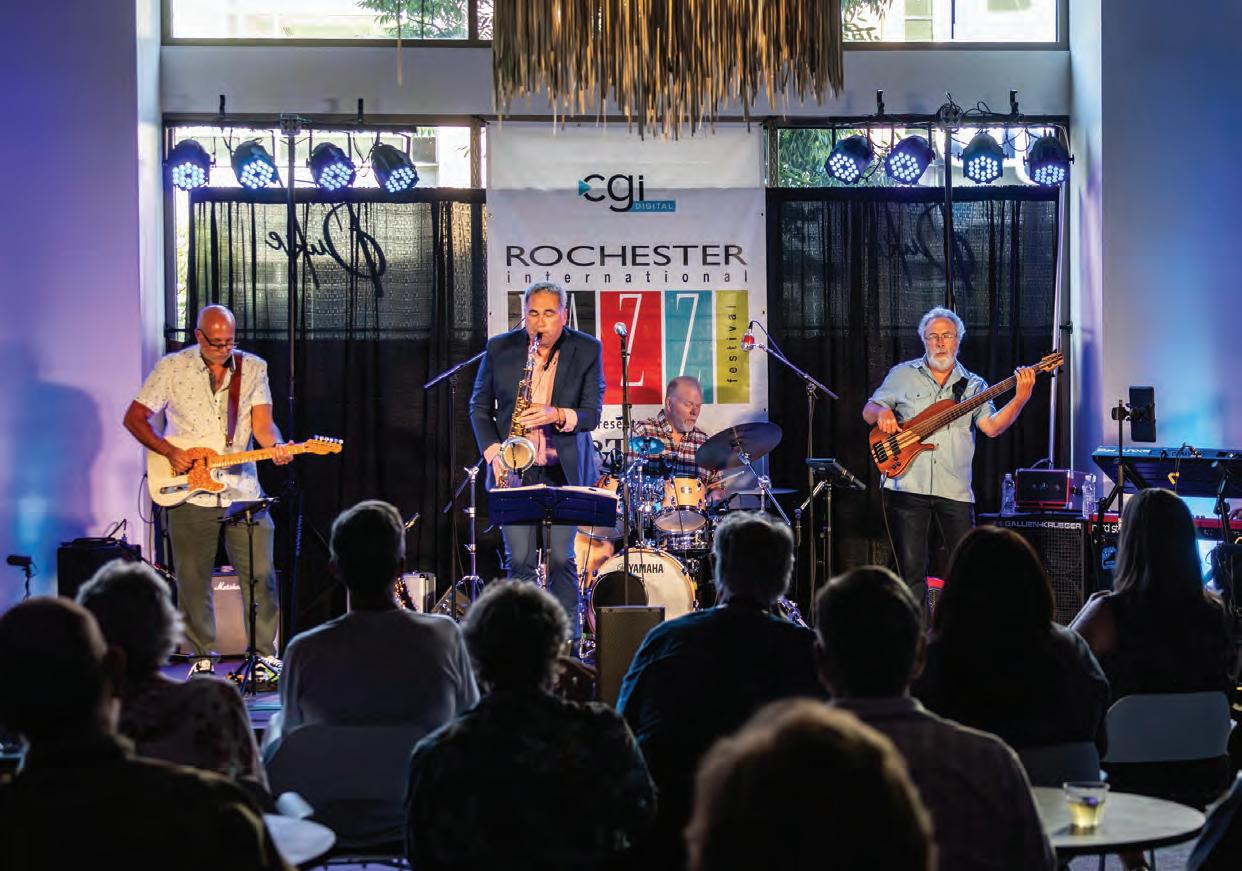
By Mike Costanza
Though Bill Tiberio can play different types of music on his sax, jazz is his first love.
“This jazz world is so wide for me,” he said. “I feel like it gives me freedom and it gives me a place where my voice feels authentic to me.”
Though he’s studied the works of Charlie Parker, John Coltrane, Cannonball Adderly and other classic jazz musicians, the saxophonist has never limited himself to traditional styles.
“I more gravitated toward music where there would be, say, a back beat, a rock beat, a straight funk beat,” he said. “That music speaks a little bit more to me.”
When he plays his horn, it’s usually as part of an ensemble.
“Playing in an ensemble is unlike anything else,” he said. “You give in to a greater good than yourself. You try to match and blend and balance and play in tune with a whole bunch of other musicians.”
And play he does.
In addition to taking gigs with his own band, Tiberio performs with a number of other local groups, including the Bill Welch Band, Uptown Groove, Up 2 Somethin’ and the wedding and party band Allegro. Primo Mussumeci, Allegro’s founder, called Tiberio “the nicest guy.”
“There’s a lot of guys that play well that are cocky,” Mussumeci said. “The attitude that they have is one that they’re better than everybody.”
Tiberio never comes across like that.
“He’s at the top of his game in musicianship…and he’s just so downto-earth,” Mussumeci added.
Scott Bradley, who has played keyboards and the trumpet with the Bill Tiberio Band since it was formed in 2008, said the experience has been “wonderful.”
“Bill is a great bandleader and probably would be a good leader in any sort of organization,” Bradley said.
Expounding upon Tiberio’s leadership style, Bradley spoke of Stephen R. Covey’s bestseller, “The 7 Habits of Highly Effective People.”
“One of the maxims in Stephen Covey’s book is ‘seek first and understand and then to be understood,’” he said. “He [Tiberio] never tries to explain anything to anyone without listening to everybody first and insists on getting the big picture before he makes a decision.”
The Bill Tiberio Band has performed all over Upstate New York and put out four CDs. In addition to playing his horn commercially, Tiberio often performs with the Spiritus Christi Church’s band at Sunday services. He is a member of the Rochester church’s congregation, as is this writer.
For more information on the Bill Tiberio Band, go to: www. facebook.com/p/Bill-TiberioBand-100063615036487


• Meals Daily
• Housekeeping Weekly
• Transportation to Medical Appointments
• Free Grocery & Phar macy Delivery
• Emergency Response System
• On-site Physician & Lab
• Assistance with Showering
• Laundry Service



To hear more of Frank’s story and learn if CyberKnife is right for you, visit hoacny.com

Frank chose non-surgical CyberKnife® at HOA –offering 5 treatments instead of 35!
“The original diagnosis was to treat my prostate cancer with seven weeks of radiation, five days a week. I was kind of upset that I was never given the option of CyberKnife,” said Frank. “The precise radiation achieved by CyberKnife, far fewer treatments, and the personalized care I received from Dr. Chin and his team made my decision an easy one. Better, the treatment was a real success!”

By Kathryne Rakowski
It seems each generation has their own language. A collection of slang words that keep older generations scratching their heads or, in these days, turning to Google.
Social media has helped new terms used primarily by the Gen Z population to spread quicker than ever before. If a celebrity uses a slang word on Tik Tok, or an influencer coins a new phrase on Instagram, this will be mainstream in no time. Are you lost sometimes when listening to your grandchildren? If so, you’re not alone. So here is a list of the top 10 slang words that are hot right now. Use them in conversations with the Gen Zers in your life to let them know you’re in the know!
Do you have rizz? Rizz is a sort of charisma that a person has or would aspire to have to attract a love interest. Someone with a lot of rizz would be able to charm a person and glean many compliments. If you happen to receive a flattering remark from someone, just tell them you’re working on your rizz game.
If someone says you slayed something, take it as a compliment! It means you did something exceptionally well. Often referring to fashion, it can be used in any context to let someone know you are very impressed with a job well done. Did your grandchild post a very flattering picture on Instagram? Comment “slay”
to brighten their day and let them know you are slang-savvy.
This word (no pun intended) has been used with previous generations and is making a comeback! It indicates that you’re agreeing with or that you understand what someone has said to you. Next time you want to agree with someone, just respond with a resounding “word.”
Bet
It’s a short and sweet word that can be used in a variety of ways. You can use it to let someone know you agree with them. You can use it to mean “OK.” And you can also use it to mean, “yes, you can count on it!” If you want someone to definitely trust
you on a prediction you are making, bet should be your go-to word.
I’m down
I’m down is a fun way to let someone know you’d like to do something with them that they may have suggested. Because, why just say “yes” when you can sound young and hip? If you are invited to do something, enthusiastically respond with an “I’m down.”
Delulu
Why use the word “delusional” when you can use the word delulu? This trendy word refers to someone who is delusional, primarily referring to a relationship. Hopefully, you won’t have to use it to describe the person you yourself are in a relationship with.
Drip
You’ll be happy to hear it if you’re drip, drippin or drippy. This has nothing to do with running water. This is another way to compliment someone’s fashion sense or convey that you love their outfit. If you like the way someone looks, tell them they have some serious drip
No, this actually doesn’t refer to an ironed shirt. If someone is pressed, it means that they are upset about something. If your grandchild tells you I’m pressed, you may want to press them for information as to what happened (once again, no pun intended). They’ll be happy you want to help and presently surprised you know what they mean.
Sus
Might not surprise you to learn that sus is short for suspect. Gen Z’s will use this term to describe an untrustworthy or suspicious person or a situation that doesn’t sound quite right. Next time something seems odd, just say, “sounds sus to me!”
Cookin’
You may think this has something to do with being in the kitchen, but not necessarily. This newer term is a way to refer to something as cool. If you want to sound really cool, just tell your family you are cooking something very cookin. You’ll be met with confusion by some and excitement by others.







Side Location: 70 Linden Oaks Dr. Ste. 300 Rochester, NY 14625
*Churchville Location: 42 S. Main St. Suite F Churchville, NY 14428 *Spencerport Location: 129 South Union St. Suite D Spenceport, NY 14559


A‘Falling’
Now you can leave that ‘fall cleanup’ of the past and continue planting through the season
By Linda Quinlan

s you contemplate your garden this fall and think about all the cleanup work that is ahead, here’s good news: leave it until spring.
A lot of people like to get their gardens neat and tidy, said Marci Muller, horticulture team leader for Monroe County Cooperative Extension, “but the recommendation now is not to do fall cleanup as you may have done in the past.”
Muller explained that not doing fall cleanup is providing shelter to beneficial insects and is seen as better for the environment.
“Generally speaking, just let it [your gardens] go through the winter,” Muller said, noting that includes the leaves, which she recommends mulching and putting in the garden or mulched and left on the lawn.
Instead, have more fun with your garden.
“Fall is my favorite time to plant anything,” Muller said. “In the spring, the weather can go from quite cool and rainy to hot and dry … that puts plants in stress. And in the fall, weeds are not as active.”
She recommends planting
perennials in the fall, but cautions, “Plant them the earlier in the fall the better, so the roots can get established.”
Anything you plant should also be mulched, too, to protect them through the winter months.
“But don’t be fooled by the cooling temperatures,” added Jane Grant, a trained master gardener through Cooperative Extension. “Your plants will still need water.”
She recommended getting an inexpensive rain gauge to try to keep track of how much water plants are getting from nature.
“You have to know your soil, too,” said Grant, who describes herself as an octogenarian. “We [in many parts of Monroe County] live on the banks of ancient Lake Ontario and our soil is very sandy. You’ve got to water all the time.”
Fall is also the best time to plant bulbs, from tulips and daffodils to alliums, Grant said. She added that her garden also has some “eye popping” plants like acanthus, known as Bear’s Breeches and Bells of Ireland.
The two have a wealth of knowledge about gardening at any time of year. Muller, who resides in East
Bloomfield, has been at Cooperative Extension for four and a half years, but also owned two different landscape companies in the past and worked for a nonprofit that taught its clients about horticulture. She formerly was on the board of the local organization, now based on St. Paul Boulevard in Irondequoit.
Monroe County is considered an urban and suburban area, so it provides research-based educational programming on a variety of topics, including agriculture, horticulture, natural resources, nutrition and 4-H youth programming.
They have a diagnostic clinic for pest issues. They are a stand-alone nonprofit, but are aligned with Cornell University, Muller explained.
They say the benefits of gardening, whether flowers or fruits and vegetables, are many.
“Gardening benefits your physical health because you’re moving, and getting fresh air,” Muller said. “Plus, it’s somehow cathartic to get your hands in the soil. And if you’re pulling weeds, it’s a great time for reflection.”
Besides poring over seed catalogs in the winter, Grant also recommends

enrolling in a yoga class to keep in shape for gardening.
Another benefit of gardening if you’re growing food and especially if you don’t use chemicals, “you know exactly what you’re getting … and maybe you’re eating a few more vegetables,” Muller added.
Speaking of vegetables, fall is not too late to plant. “In September, you can still plant quick turnaround vegetables like radishes and any salad greens: lettuce, spinach, chard, beet greens, etc.,” Muller said.
The traditional time to plant garlic is also after the first full moon after the first frost, she said. It stays in the ground until mid-July the following year, when it is harvested.
If onions, potatoes and carrots are planted by late summer, they can also withstand a couple of frosts, Muller said, “but you have to give them time to develop (before a frost). September would be too late to plant them.”
“One thing about gardening, though,” Muller added. “If you don’t experiment, then what’s the point?”
When it comes to gardening as people age, Muller recommends “adaptive” gardening like raised beds

2.Perennials like these alliums, coneflowers and black-eyed Susans, from the gardens at Cornell cooperative Extension, can be planted in the fall.
3. Red honeysuckle and orange butterflyweed bloom in master gardener Jane Grant’s Rochester garden. She said both are native plants and attractive to pollinators. Perennials like these can be planted in gardens in the fall, so they will bloom next year.
and having a kneeling bench with handles, for help with getting up.
Grant also recommends always having a cell phone or what she calls “a magic watch” nearby when out in your gardens. “I had a neighbor who fell down a hill and she was there quite awhile before someone found her.”

Grant even upcycles old jeans by stuffing them with foam for kneeling pads and uses the pockets to make bags to hold her cell phone, should she need it.
She plants mostly flowers, Grant said, but also specializes in berries — raspberries, strawberries, blueberries and blackberries. She turns them into jam which she packages and has been selling at Green Acre Farm in Greece for around 35 years. She’s beginning to downsize a bit, though, and may produce only about 100 to 150 jars of jam this year. Some years, she has made up to 250 jars of jam.
Of course, all this talk about planting in fall and not doing that fall cleanup does mean more work in the spring, the two agree, but then there’s that eagerness to get your hands back into the soil after a long winter.
“Some research has shown there’s something in the soil that affects the dopamine in your brain and helps your mood and sense of well being, too,” Grant said. “You just feel better when you garden.”
By John Addyman
When you look in the mirror, do you see a 17-year-old staring back at you? Is the image smiling or pensive?
Are you unsure of the future or confident you’ll go boldly into life?
Do you wonder if your dreams will come true?
Are you thinking about friends that know that face? Your face?
It’s a moment that more than 100 members of the Rochester East High School Class of 1964 spent in June before they gathered for their 60th reunion with their classmates.
Getting out of their cars in the parking lot at East High, careful to be wearing a yearbook photo badge with maiden and married names, every graduate looked serious for 10 seconds, then broke into a smile of recognition and, well, love.
So many smiles. So many happy hearts.
The weekend had started with a gathering on Friday night. Now, on Saturday morning, people were ready for a big day, full of exploration and get-together — a tour of the newly refurbished East High, a golf outing and, finally, a big dinner.
Joose Ong didn’t look a bit jetlagged, but she had come to this special event from Singapore. In 1964, she was a foreign exchange student from Malaysia. The last reunion, the 55th in 2017, took her 19 ½ hours of airtime to get here.
“These are my friends,” she said. “I love coming here. But this time, I did a more leisurely trip. I flew to England and rested for three days and then flew to Boston and then to here.”
She had left East to attend university in Singapore, earning degrees in political science and public relations and linguistics. She has been a lecturer at Singapore Technological University.
“Last night was so much fun,” she said. “Everyone was so happy.”
Lenore and John Harman were high school sweethearts at East. John graduated in 1961 and Lenore finished high school in 1964. He went to Clarkson and became an accountant. Together for 59 years, they have three sons, five grandkids and five greatgrandkids.
In truth, Lenore had to be talked into attending this reunion. “I was at the 10th reunion,” she explained. “There were so many divorces and deaths. I didn’t want to go back to another reunion.”
Peggy Laws Germano and husband, Nick, have also been married 59 years. Now living in North Carolina after a career in bank management, Peggy had feelings similar to what Lenore Harman voiced.
“This reunion was sort of bittersweet because we had so many classmates whose spouses had died. I just spoke to two of them,” Peggy said. “The reunion committee also sent out a list of those who had died and there

are still so many of our classmates they couldn’t find.
“I was torn about deciding whether to come or not. I knew this one is really the last one I’ll ever get to, considering my age. I’m not sure if I’ll be around for another one. But it’s been wonderful, full of hugs and a wonderful experience for me.”
She was surprised to see “how people had aged so. You think of them as they were in high school when we were 17, 18 years old. Or even some other reunions where people

hadn’t aged much. But this one is like, oh my gosh!
“I think people do look really good but there are others who are suffering from different ailments. That really bothers me. You just kind of think it’s never going to happen to you.
“There’s been a lot of hugging, yes. I’m a hugger by nature. Everybody just hugs when we see each other. It’s been wonderful to see them.”
Tom Allen saw an old classmate come in the door for the dinner on Saturday night at the Italian American
Social Club on Buffalo Road. She did not know her own name. She had an aide with her.
“It’s tough to see some of my friends like that,” he said. “Five years ago, at the last reunion, she was bright, beautiful.”
Remarkably, the woman who had trouble with her own name was picking people out of the audience — by name — as she walked from table to table. She was supposed to stay for 30 minutes or so; she was there well past an hour, smiling the whole time.
“She wanted to be here ‘to see some of the kids,’” Allen said, “some of her classmates.”
Allen has had a career in teaching from grade school through collegiate grad schools and has his Ph.D. from Southern Illinois University. Gregarious and accommodating, he had fun and others had fun with him.
“Life is connections,” he said. “You have to stay connected. You have to see people. You have to touch them; you’ve got to talk to them. You’ve got to do those things.”



His early years in Rochester were definitely formative and he has a special place in his heart for East. “Sports-wise, we had some good teams,” he said. “The influence of your peers can’t be overstated in terms of who we are. I hung out with a lot of jocks.”
Fellow grad Marilyn Gattelaro Spampinato pointed out that when East opened as an 8th grade through 12th grade junior - senior high school in 1959, the future Class of ’64 would be the first group to experience every grade offered. She described East as a “neighborhood school” with 533 students graduating in 1964 at the Eastman Theater.
“We came from diverse neighborhoods and used to walk or ride the bus to school: such a different time,” she said. “Our hang-out spots were the ‘Orient’ across from East, ‘Critics’ on Goodman and Main streets, The Goody Shoppe on Clifford and
Goodman, Carvel at Main and Culver. Just about everyone knew each other since we all lived in the surrounding area.”
For the Saturday tour, a classmate and former principal, Eddie Mascadri, welcomed everyone in the door — past the metal-detecting machine — and into a broad well-lit lobby. His youngest son, also Eddie Mascadri, is now the principal of the high school, finishing his first year.
The elder Mascadri promised, “For a slight fee, I can get all your records changed.”
“So it isn’t too late to change my grades?” Class of ’64 grade Gary Rivoli asked the young Principal Mascadri.
Both Mascadris laughed.
Claire Howell, in from Boston, underlined why it was important for this group of graduates to tour their
old high school: “We walked through these doors together,” she said. “We walked these halls with our friends.”
Principal Mascadri led the group on the tour. In the auditorium, which is due for renovation, he explained that nine years ago East was graduating 32% of its seniors and was in state receivership as a failed school. Since then, through a partnership with the University of Rochester Warner School of Education, East High has been reborn. He expected 81% of the class of 2024 to graduate, for starters.
He pointed out that East is now a “community school” where many of the services kids and families need are right there — a doctor on staff full-time, a dentist, mental health professionals, a food closet and a barber shop.
“A significant amount more money was spent here than in other schools to support our program,” he said.
“We’ve had visitors from U of R on a daily basis,” he added. “East is


the most-used building in the district because of the music, bands, choruses and special programs here. No cell phones are permitted onsite.”
Mascadri spoke about the 9:15 a.m. “family meetings” in classrooms that cover a range of needs and issues and news important to kids. The school provides so much of the community within its walls there are few remaining needs for kids to leave the building.
In the high-tech modern “collaboratorium” room, Mascadri explained how the room is used for staff meetings and professional development classes. Questions from the graduates, who were obviously still deeply invested in their old school, included those about continued funding and further improvements here.
For these folks, East pride runs deep.
“I was so happy to see all those
changes,” said Janice Corea. “The building looked really good and again, I’m one of those people who have heard the bad press the city schools were getting, East High in particular. I also heard about the changes that happened when the U of R came, so, I was very hopeful.”
“Also, these changes are a progression, things needed to change in East High,” Corea added. “Even in my neighborhood when children were growing up, a lot of parents still sent their kids to East High because they could take AP programs and that’s why I asked a question on our tour if there are programs like that. But now there are not many. The Regents and some AP classes are there, but their goal is to really build a community in that school, which I feel is so important.
“What really impressed me on the tour was when the principal spoke about the 9:15 to 9:45 ‘family’ meetings. My heart bleeds to think about how
the neighborhoods have changed and the stresses families have had. And the poverty in Rochester: it’s really so overwhelming. That’s why I felt so good when he talked about offering an optical (spectacles) program, we’re offering a culinary arts program. The kids can come and get dental care here. We have a doctor on staff. These students really need emotional support because I feel that’s truly what could be lacking in their homes.
“I remember when I was in school the first few years at East I was very shy and I wasn’t a cheerleader or anything like that. I started taking art classes and drama classes and those were the classes that brought me the greatest pleasure and sort of brought me to life at East High.
“My art teacher was very inspiring to me. He wrote in my yearbook, ‘Do something with that talent you’re loaded with.’ I’ll tell you, I had never had anyone say that to me, so it took



me a while. I worked for a year, then went on to RIT to study art and design and I did have a career in the arts as a graphic artist. Thank goodness a teacher said that to me.”
Jacquelyne VanAs Greene was captain of the cheerleaders 60 years ago and still charms with a great smile. She had a career as a nurse and was the director of nursing at St. Ann’s Community when she retired.
“It’s the camaraderie of everyone,” she explained as the important thing about reunions. “Keep everyone happy and alive. At our age [average78.5], we’re not young. This reunion is about getting to know each other all over again and seeing people after all these years. Of course, people have changed, but it’s amazing how much connection you have because we all went to school together: the connection is there for life.
“Our class was big but I had a lot of friends in a lot of different areas. I was blessed with friends,” Greene added.
Peggy Germano added a story about the welcoming get-together on Friday night: “There was a couple who didn’t have name tags on. But then I watched them while they were talking and said to myself, ‘Oh my gosh, that’s Gene Duffy.’ I didn’t see a name tag on him, but a lot of people I just recognized immediately.”
“This, for me, may be the end of the story,” Germano added, getting an apologetic, sad look on her face. “I don’t know how to say it, but I’d rather not just come back again. There was so much where my heart was aching when I heard about so many classmates who were sick or died. I’d rather leave it at this because it’s been such a wonderful, peaceful reunion.”
An anonymous quote helps reflect on why a reunion is important: “When the mirror becomes your enemy, nostalgia becomes your friend.”
Most of us have a little trouble wrapping our consciousness around a 59th wedding anniversary, much less a 60th high school reunion.
What the East High School Class of 2024 shares, all those veteran married folks and long-ago students, is heart for one another, pride in their school from 60 years ago and now into the future and the feeling that they were a special bunch the likes of which Rochester may never see again.






Life in balance.
We are growing and have exciting career opportunities in the health care industry.
To join our talented, professional team, please visit one of our care facilities career pages for available positions.
We are growing and have exciting career opportunities in the health care industry.
We are growing and have exciting career opportunities in the health care industry.
A company philosophy that speaks to a continual process of individual and collective development to improve our well-being, quality of life and personal relationships.
Life in balance.
To join our talented, professional team, please visit one of our care facilities career pages for available positions.
Our Mission.
Life in balance.
A company philosophy that speaks to a continual process of individual and collective development to improve our well-being, quality of life and personal relationships.
Our Mission.
To provide people in our community with healthcare, customer services, support & employment to achieve their individual best quality of life.
Life in balance.
A company philosophy that speaks to a continual process of individual and collective development to improve our well-being, quality of life and personal relationships.
Our Vision.
A company philosophy that speaks to a continual process of individual and collective development to improve our well-being, quality of life and personal relationships.
To join our talented, professional team, please visit one of our care facilities career pages for available positions. 17 Sunrise Drive Oswego, NY 13126 315-342-4790 | www.morningstarcares.com
available positions. 17 Sunrise Drive Oswego, NY 13126 315-342-4790 | www.morningstarcares.com 220 Tower Street, Waterville, NY 13480 315-841-4156 | www.watervillecares.com
Our Mission.
To provide people in our community with healthcare, customer services, support & employment to achieve their individual best quality of life. Our Vision.
To redefine skilled nursing care through successful team development, use of technology, progressive service and being a strong community partner.
Our Mission.
To
Our Team.
To redefine skilled nursing care through successful team development, use of technology, progressive service and being a strong community partner.
To provide people in our community with healthcare, customer services, support & employment to achieve their individual best quality of life.
Registered Nurses
Licensed Nurses
Our Vision.
Our Team.
Physical Therapists
Our Vision.
To
Occupational Therapists
Registered Nurses
Licensed Nurses
To redefine skilled nursing care through successful team development, use of technology, progressive service and being a strong community partner.
Speech Therapists
Physical Therapists
Our Team.
Social Workers
Our Team.
Occupational Therapists
Speech Therapists
Registered Nurses
Recreational Therapists
Registered Nurses
Licensed Nurses
Dieticians
Social Workers
Nurse Aides
Licensed Nurses
Physical Therapists
Physical Therapists
Occupational Therapists
Occupational Therapists
Speech Therapists
Speech Therapists
Social Workers
Recreational Therapists
Recreational
Recreational Therapists
Dieticians
Nurse Aides
| www.morningstarcares.com
13126 315-343-0880 | www.thegardensbymorningstar.com
Tower Street, Waterville, NY 13480 315-841-4156 | www.watervillecares.com
CARE CENTER 100 St. Camillus Way, Fairport, NY 14450 585-377-4000 | www.aaronmanor.com

By Linda Quinlan
It’s common to hear that someone is going out to run a few errands.
The question, though, is whether they will actually be running.
A group of adults, mostly women, met at Seneca Park twice weekly this past summer to do just that — run.
They were enrolled in On Your Feet to 5K, a “learn to run” program taught by Kelly Nash, a level one and two certified running coach through RRCA, the Road Runners Club of America.
The class also had the support of the Rochester Running Company. Their “graduation” run will be the fourth annual Heritage Hero Run 5K to benefit Heritage Christian Services, where Nash has worked for 31 years. She currently is the part-time guardianship coordinator for Heritage and also has a hand in planning and organizing the Sept. 7 run through Seabreeze Amusement Park in Irondequoit.
Not surprisingly, to Nash, who is 53, 11 of the 27 participants in this year’s class were age 55 and older.
Karen D’Angelo, 68, said she is the one who encouraged friend Susan Donovan, 72, to get into running and join Nash’s class.
Donovan had been working with a trainer, but found power walking, to start, with Nash helped her reach her goals, too.
“It’s all helping me keep strong,” she said.
Nash herself didn’t start running until she was 35 and struggling with the loss of her father at age 57.
“I got this postcard from the Stroke Association about a train to end stroke marathon,” she recalled. “I had never really run before, but I signed up!”
She ran her first marathon, in Hawaii, in 2006.
“I loved how it helped me emotionally and mentally,” she said.
Today, Nash has now completed
26 full marathons (26.2 miles) and 27 ultra races of 26.3 to more than 31 miles.
Along the way, Nash said she started to figure out that running could help her give back.
“As I’ve gotten more mature, I realized it wasn’t just about me, but about sharing it,” she said. “Movement can help us feel better and respond to the community in a healthy way.”
She started coaching with Fleet Feet’s new runner program, but said she eventually realized she’d prefer working with smaller groups.
By 2012, she had formed her own business, Running with Kelly and was off and, well, running.
“I liked the earthy sense of Running with Kelly,” said Sandy Iacchetta, 58, who was enrolled in Nash’s summer program, even though she has already completed a full marathon. “She [Nash] is about the whole person. And, there’s a flexibility to her programs.”

Cathie Trabucco, 64, joined Nash’s class this summer as a mentor to newer students.
Trabucco said she didn’t start running seriously until age 52, though she had started doing triathlons (generally swim, bike, run events) five years earlier.
“I was a swimmer and a tomboy, but I hated running,” Trabucco said. Then she met Nash. “Swimming will always still be my go-to, but now I love ultra running; you’re in nature and in the moment to the extreme. And you’re with like-minded people who are all high on life. Just thinking about it makes my heart happy.”
Still, Trabucco said she is appreciative that she still has good health and the ability to move like she wants. Just since June, she has completed two 33-mile races, a 5K (3.1 miles) and a half marathon (13.1 miles).
“I don’t plan on doing any less, either. Age is not a factor,” she said.
Nash said that she has noticed, at races she attends or participates in, she is seeing more runners of all ages, from 8 to 80.


LEFT: Participants of the On Your Feet to 5K program, led by Kelly Nash, set off on a run. Photo submitted.
MIDDLE: Kelly Nash, the owner of Running with Kelly, leads a program, On Your Feet to 5K, that trains people to run. She is a level one and two certified running coach through RRCA, the Road Runners Club of America. Photo by Linda Quinlan
The group of women warm up to run.
“It’s neat,” she said, noting, “People are living longer and it’s important we move, whether it’s gardening, doing stairs or running. Your heart is a muscle and what happens to muscles if you don’t use them … they atrophy. Running strengthens muscle.”
Trabucco goes so far as to say, “Running is a natural aphrodisiac,” but quickly added that attitude is also important.
Betty Peters, now 65, said she got into running at 53 because she was “in crappy health.”
“The first appeal was that running was something I could do outside in any weather, and no special equipment was needed,” Peters said. She now finds running both challenging and rejuvenating.
Peters said she would and has, referred others to Nash.
“You don’t just put on your sneakers and think you’re going to run a mile; you have to work up to it,” Peters said. “Your body has to acclimate to it.”
Nash’s classes have helped with
that.
“Kelly’s groups are very much like a family; you have each other for support,” Trabucco agreed.
It’s hard to embark on something new on your own, Peters added. “I liked Kelly’s approach; it’s more individualized.”
Not to mention that Nash is also a powerful example, Trabucco said.
The hardest part is the mental part, Trabucco added, “but it’s just showing up. You don’t start with expectations that are too high. Be gentle with yourself.”
“Some days, I give myself credit for just putting on my shoes and going outside,” Peters said with a laugh.
At some point, Nash added, you just have to realize what’s important is being able to take care of one’s self. Running can be a part of that goal.
For more on Nash’s programs, find her page, Running With Kelly, on Facebook. For more on the Sept. 7 Heritage Hero Run, go to HeritageChristianServices.org

By Jim Miller

If you or your wife spend much time online, adding a separate digital will document to your estate plan that provides a list of your digital assets would be extremely helpful to your loved ones when you die, not to mention it will help protect your privacy. Here’s what you should know.
The term “digital assets” refers to personal information that is stored electronically on either a computer or an online cloud server account that belongs to an individual. Anyone who uses email, has a PIN code protected cell phone, makes online purchases or pays bills online has digital assets.
Digital assets generally require a username, a password or a PIN to access and can be difficult, if not impossible, to retrieve if someone is incapacitated or dies.
Creating a digital will (also known as a digital estate plan) will help your loved ones access your electronic devices and online accounts
Prepare for new opportunities that stimulate engagement, feed your curiosity, and inspire a fresh desire for learning. St. John’s full array of service options address evolving needs within compassionate community settings.
• Independent Senior Living
• Enhanced Assisted Living
• Respite Care
• Rehabilitation
• Skilled Nursing Care
• Dementia Resource Center
• Hospice Care
Many life-enhancing choices await you.
SCHEDULE A TOUR TODAY. 585-760-1300 | stjohnsliving.org
more easily so they can manage your electronic affairs, according to your wishes, after you’re gone. This in turn will also protect your digital assets from hackers or fraud, which can happen to dormant accounts after you die.
Your first step in creating a digital will is to make an inventory list of your digital assets, which includes everything from hardware to email accounts. Here are a few categories to help kick-start your list:
• Electronic devices (computer, smartphone, tablet, external hard drive).
• Digital files (for photos, videos or documents)
• Financial accounts (like bank and brokerage accounts, credit cards, cryptocurrency).
• Bill paying accounts (utilities, mortgage accounts)
• Social media accounts (like Facebook, Instagram, Twitter, LinkedIn).
• Email accounts (Gmail, Yahoo, Outlook, etc.).
• Cloud-storage accounts (like Google Cloud, iCloud, Dropbox, Microsoft OneDrive)
• Movie or music streaming services (like Netflix, Hulu, Spotify, Apple Music)
• Online purchasing accounts (like Venmo or PayPal)
• Subscription services (magazines, newspapers, Amazon Prime, etc.).
• Reward programs (travel, stores, etc.).
• Memb ership organizations (AARP, AAA, etc.).
When making your list, you’ll need to include usernames, passwords, PINs, account numbers or security questions for accessing each account. And provide instructions on how you want your assets managed after your death. For example: Do you want certain accounts closed, archived or transferred? Do you want specific files or photos to be deleted or shared with loved ones? Do you want your social media profiles memorialized or deleted? Be clear and specific about

your wishes.
You’ll also need to appoint a digital executor that you trust to execute your wishes after you die.
From a legal perspective, you should know that most states have enacted the Revised Uniform Fiduciary Access to Digital Assets Act (RUFADAA), which legally recognizes digital estates. This law gives your personal representative or executor legally protected access to your online accounts.
Once your digital will is written, store it with your other estate plan documents either in a fireproof safe or file cabinet at home, on your computer hard drive, with your estate planning attorney or online at a reputable digital estate planning service like Everplans. com or Clocr.com. But make sure your executor knows where it is and has access to it.
Also remember to keep your digital will updated regularly when you create any new digital accounts or change passwords.

In the Demo Center, Hearing Loss of America Association members and retired engineers Lorin Gallistell (left) and Eric Matson (right) discuss assistive devices with Joanne Ambrose. People concerned about their hearing loss can get a lot of wisdom and suggestions from HLAA members, publications, meetings and website (HearingLossRochester.org). The coordinator of the center is Chas Johnstone (not in the photo). She led the effort to establish it and selects, maintains, administers and schedules everything.
By John Addyman
“Here’s a statistic,” said Art Maurer. “One out of 10 people in the United States who need hearing aids actually have them.”
Maurer, 84, was sitting in his dining room in Penfield. Next to him was Sue Miller, 85. They both have significant hearing loss. And with their 40-year-old chapter of the Hearing Loss Association of America, they live to help others.
It’s possible that you’re one who could benefit from that help.
Do you have stress in your living room because you want to turn up the volume on the TV but your spouse says, “No! That’s too loud!”
When you’re at a social gathering, do you have trouble understanding what your friend nearby is saying because there are people around the two of you and you can’t pick out exactly what’s your friend is saying?
Have you ever given a talk and had to ask people to repeat their questions because you “didn’t quite get it”?
The Rochester Chapter of the Hearing Loss Association of America (HLAA) can help you.
In many ways.
“Our organization makes it safe,” said Miller. “One of our goals is to make it safe so you don’t feel stupid, you don’t feel ignorant in saying to people, ‘I can’t understand you because I have a hearing loss. Please slow down. Please look at me when you speak. Please raise your voice a little.’”
Is that person you? Do you have a hearing loss?
Let’s be frank: many of us get to a point in our lives when someone we love and respect asks, “Are you having trouble hearing?”
Or your spouse lays it on the line: “You should look into a hearing aid.”
“We provide support, education and advocacy,” said Maurer, who is the retired president of the HLAA. The Rochester chapter has 300 paid members and 600 people on its newsletter list. It’s the biggest chapter of the HLAA in America. And for good reason.
“We help people who are thinking of getting a hearing aid or, according to their caregivers, ought to be thinking about getting a hearing aid,” Maurer said. “We can help them understand how to go about getting a hearing aid, because a hearing aid is one of the hardest things to buy — people don’t know anything about it when they start. Nobody knows the manufacturers, who to talk to. They don’t know the features available…but they do know that hearing aids are very expensive.”
HLAA can really help with seasoned advice and hands-on demonstration. The group has a threehour course, “How to Buy a Hearing Aid” available through its website — HearingLossRochester.org — and its free. “We also have a course on “speech (lip)-reading,” Maurer adds.
Want to see what’s available to you in hearing assistive devices (you may need something, not a hearing aid), HLAA hosts a “Demo Center” at Lifespan on South Clinton Avenue, from 10 a.m. to 2 p.m. on the third Thursday of every month, September through June.
“That’s a walk-in,” he explained. “We will greet people. We get to know them a little bit. We’ll ask, ’What brings you here?’ What we have is over 30 assistive listening devices laid out around the room and they are all working. Depending on what the person’s need is, we may steer them toward thinking about an audiologist, or we may help them get an assistive device that will help them immediately. None of these devices can be bought locally — it’s all mail order now. The beauty of it is that people get to try something out before they order it.”
And the Demo Center is free, manned by volunteers — many of them engineers — from HLAA.
Miller, who is coordinator of the administrative division of HLAA in Rochester, notes that “We do not demonstrate hearing aids at the Demo Center. People may come in thinking they’re going to see hearing aids. We do not have them.”
“We don’t dispense hearing aids at all,” added Maurer. “We don’t have the professional credentials to do that. However, we do have a kiosk, an ‘Express Hearing Test.’ In five minutes, we can have a person do an assessment of their hearing which would indicate, ‘Should I see an audiologist or not?’
“Anybody who’s thinking of buying a hearing aid, whether from an audiologist or over-the-counter, we tell them: ‘Get tested by a professional. You’ve got to know your level of hearing loss.’ The new over-thecounter devices only work on mild to moderate hearing loss; if you’re beyond that, you need a regular hearing aid. We don’t sell anything. We don’t represent any manufacturers. We just help people realize what’s available and how to get it. That’s why



Thinking about transitioning into a smaller home, assisted living or aging in place? We can make your life easier and lay out a plan that will fit your needs. Call us to discuss the right move!
• Getting your home ready to sell
• Downsizing options
• Rightsizing options
• New builds with handicap options
Richard J. Borrelli
CRS,GRI,SRES,CBR






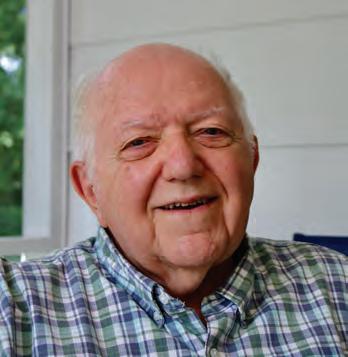

the Demo Center has become quite popular.”

If you’re ready to start your journey to better hearing, consider attending one of the monthly chapter meetings which run October through June on the second Tuesday of the month, at 11 a.m., in St. Paul’s Episcopal Church

at 22 Westminster Road in Rochester. Those meetings are followed by a presentation at noon, and are preceded by a smaller group that meets at 10 a.m. downstairs – HOPE (Hearing Other People’s Experiences), which is run by audiologist Joe Kozelsky.
The noontime speakers hit common topics like tinnitus and at least once a year there’s an “Ask the Audiologist” session with a presentation then a long question-and-answer session.
Maurer and Miller say HLAA is on top of the rapid changes in hearingassistive technology, like the over-thecounter mail order hearing aids we all see on TV. The chapter has published a “tip sheet” about things to know and consider when you’re thinking about an OTC hearing aid.
First, OTC hearing aids are intended for mild-to-moderate hearing loss. To be clear about what kind of help you need, get tested by an audiologist first. If you buy an OTC device, be sure it includes a 45-day trial period and can be returned for a full refund.
“The rule of thumb right now,” says Maurer, “is that if the OTC hearing aid you’re buying is less than $800 to $1,000, be very, very careful.” He adds that there is “some quality stuff coming from known manufacturers who have some experience with speaker systems, like BOSE. Those are $1,200 to $1,500 and the results are pretty positive as long as you’re in the (hearing loss) range for an OTC device.
“If you have a profound hearing loss and the audiologist gives you a hearing aid that’s capable of really offering you the power you need, he
can’t turn that thing on full power when he gives it to you — he’ll ramp it up over time. And a good audiologist will tell you that you don’t need a hearing aid.”
Maurer said the more powerful, audiologist-prescribing hearing aids start at $2,500, with $4,000 the midrange and $6,000 the top. These aids come with a three-year warranty. And three years of support and service.
That Demo Room showcases more than 30 assistive devices, things that boost sound. For instance, there’s a TV Listener, a wireless speaker that provides clarifying sound for someone without the blaring volume.
Maurer said when he and wife Ellen were having trouble negotiating a shared level for TV volume, HLAA engineer Lorin Gallistell suggested they test a TV Listener system available on Amazon for $130.
Setting the system up, Ellen and Art were happy within five minutes.
“Ellen said to Lorin, ‘You should be a marriage counselor,’” said Maurer.
There are also devices for people who have hearing aids but need some help, like when there’s a conference table and everybody’s speaking. A small portable mike put in the middle of the table picks up what people are saying and it feeds into the Bluetooth connection in your hearing aid.




So, if you’re having trouble hearing some things and have questions and concerns, the HLAA is all ready for you.
Membership in the all-volunteer HLAA gets you access to everything for $10 a year, including the newsletter and everything available through the website, plus the company of many who have shared your experience.
HLAA advocates hearingfriendly environment in theaters and restaurants and at the airport, which has a wired system to help those with hearing loss. Miller especially advocates for self-advocacy, helping people say those uncomfortable things: “I can’t hear you. I have hearing loss. Please speak up. Please look at me when you’re speaking. Please slow down.”
“We make it safe for people who don’t hear well,” she promised.



By Jeanne Strining
One step, another step, repeat, repeat. Back-and-forth across the warm water pool at the Schottland Y.
I was water walking, something I had secretly disparaged as being for “old ladies.”
Though being active has always been important to me, my commitment to it has waxed and waned over the years.
Growing up I spent a lot of time playing outdoors. I rode my bike, I hiked, I swam, I skied. As an adult with a family and full-time job, I often used the excuse, “I don’t have time,” or “I’m too tired,” to be less rigorous in my exercise.
At least my job as a classroom teacher and then as a building administrator kept me on my feet and moving. Then, as a central office administrator, I found most of my day and many evenings that I was sitting in meetings or at a computer.
I needed to up my game.
I started weekly Pilates lessons. I joined a gym and did aerobic workouts on the treadmill and elliptical. I
eventually worked with a trainer to add weights to my workouts. After retirement, I really got serious about my exercising. Body pump classes with free weights and barbells became part of my routine every second or third day. The music energized me, but, bit by bit, the large number of repetitions with heavy weights began to take a toll on my joints. I modified my weights and movements and spaced the classes further apart. Eventually I was doing the class with so many modifications that I knew it was time to try something else.
A friend suggested that I start swimming laps, an exercise I had sworn that I would never do. I hated swimming laps. I found laps too tiring and too boring. Nonetheless, in an effort to improve my workout routine, I gave it a try. Swimming even 10 lengths of the pool was a challenge, but gradually I started to enjoy the feeling of accomplishment. I could swim a little further each week and I loved the reward of a good soak in the whirlpool afterwards!
Eventually I got myself up to
swimming a kilometer (44 lengths) two or three times a week. I continued my Pilates and added a strength training class. I started spin classes; cycling is a great aerobic exercise and easy on my joints. I wasn’t going to let getting older derail me! But I hadn’t counted on an accident.
Out for a walk with friends one winter day, I slipped on the ice. Down I went on my left shoulder, breaking my humerus. I was loaded into an ambulance and whisked off to the ER. Then the long, painful journey to recovery began. Frustration and discouragement would eat away at me. Was I too old for such an active life or was my active life prematurely aging me?
Becca Levy, Ph.D., and her recent book, “Breaking the Age Code, How Your Beliefs About Aging Determine How Long and Well You Live,” came to my rescue. Levy is a professor of epidemiology and of psychology at Yale. The book details her many research studies that demonstrate how negative age beliefs dominate our culture and play a significant role in the development of many health problems. She also shares data and real-life examples that demonstrate how positive age beliefs can result in the extension of one’s life expectancy by 7.5 years.
Take a moment right now to think about your attitude toward aging. Try a simple activity that Levy gives her students: Quickly list five words or phrases that come to mind when you think of an older person.
(Pause and try it.)
How positive or negative is your list? Like many countries, the United States has a very ageist culture, so if your list is on the negative side, it’s probably because you have been bombarded with negative stereotypes.
Another interesting fact: the term “senior moment” was popularized by a Rochester Democrat and Chronicle columnist in 1997 in reference to someone who forgot his tennis score. To quote from Levy’s book, “Nearly 150 years ago, William James, the ‘father of American psychology,’ described the phenomenon as a gap in the mind ‘that is intensely active.’” It is not a neurological condition of age; memory lapses can and do occur at any age.
So, to combat ageism I choose to think of forgetfulness simply as a result

of my having “too many balls in the air” or a lack of focus. I have a hearing loss not because I’m “old,” but because I have exceptionally narrow ear canals and had a bad ear infection resulting in tinnitus. I slipped on ice and broke my arm because in the pathway a puddle caused by the winter thaw the day before froze overnight. Even though my broken arm is fully healed and I can swim laps again, I continue my water walking because it is good exercise for my hips and legs, not because I am an old lady!
By Jane Eggleston
Jeanne Strining, a Rochester native who earned her bachelor’s degree at Tufts and her master’s at Wheelock College, returned to the Rochester area. In pursuing her vocation as a teacher, she was discouraged by the standard formulaic approach to teaching writing that led to dull results. after workshop method, things changed. She found it exciting and it not only inspired her students but herself to write.
Osher Lifelong Leaning Institute (Osher at RIT) and has found it a great opportunity to make new friends from varying backgrounds, to take interesting courses and to participate in the walking, travel and photography groups at Osher.
into a ‘retirement rut.’ many opportunities to learn new things and meet new people,” she said.
vehicle for pursuing her writing while teaching others.
led the course Writing Workshop in which she provides a short lesson in some aspect of writing, gives students time to write, then has them split up into small breakout groups to read their stories and receive helpful, positive feedback. She says that teaching older adults is the best because they have such interesting stories and perspectives, gleaned from a lifetime of living.


October 3
What’s New at The Strong?
October 17
We’ve Been Hacked: RIT Cybersecurity to the Rescue!
October 24
How the Microbiome Impacts Human Health
October 31
You Live on Stolen Lands: The Canandaigua Treaty
November 7
Two Days After the National Election: What’s Next?
November 14
What Does It Take to Protect and Serve the Citizens of Rochester?






By Deborah Jeanne Sergeant
If you enjoy frequenting farm stands, consider purchasing a community supported agriculture (CSA) share for the winter season. Typically, CSAs provide local buyers with a pre-determined amount of farm goods for a set price. Farmers receive cash flow and an established market for their goods. Customers receive regular portions of the freshest food around while supporting a local business.

The reasons for buying CSA shares are obvious to Stephanie Varley, market manager for Kirby’s Farm Market in Brockport.
“When you have fresh produce, it’s a big difference in quality,” she said.
The farm stores its apples in a climate-controlled environment all winter so “they go in fresh and come out as fresh,” she said. “They taste a lot better than what you get in the store.
In addition to picking up their share of apples each month, members can also purchase onions, potatoes, honey and frozen sour cherries at the market.
At time of publication, the farm is still deciding on the cost for winter CSA apples; however, last year, it ranged from $49.50 to $216.
At Fellenz Family Farm in Phelps, Erik Fellenz, owner, operates a winter CSA from mid-October through the end of December. His CSA provides
storage crops like potatoes and onions, along with shallots, greens, kale, Swiss chard, bok choy, and arugula as part of its shares.
As to why people buy CSA shares, “I think the big driver is that finding good, fresh local food has become more difficult,” Fellenz said. “A lot of farms of my scale will primarily run from early June-maybe early October. Then for the most part, they’re just closed until spring.”
His winter CSA shares are about $18-45 weekly for 10 weeks. Members can pick up shares at sites in Rochester, Geneva, Canandaigua and at the farm in Phelps.
Fellenz likes to keep the CSA openended for the subscribers. He provides a free choice of the items available in a particular week and customers can choose a certain number of items based upon what they like.
“We try to set it up so people who don’t like kale or tomatoes or can’t use things, are not forced to take something they can’t use,” Fellenz said. “In addition to the CSA, we sell
at one farmer’s market a week and occasionally have a farm stand on the farm. We can afford to be flexible like that. The CSA members have first choice and whatever’s left goes to the market.” Most CSAs offer pick-up from the farm or from other locations each week. Farms that offer summer shares usually sell items as they come in season. Customers have a good idea of the types of fruits and vegetables they’ll enjoy, but most CSAs warn that customers will need to remain flexible if the harvest isn’t what the farm expects. For instance, that Swiss chard may replace the endive if the Swiss chard didn’t do well this year.
Some CSAs may supply goods from other farms along with their own. Some include meat, dairy, eggs, cheese, baked goods, jams and jellies and other value-added goods.
Winter CSAs tend to focus on “root crops” like potatoes, turnips, carrots and sweet potatoes. They may also offer storage crops like squash, pumpkins, onions and apples. Some use greenhouses to extend the growing season for a few weeks, offering greens into the fall.
Cornell lists CSAs at https:// monroe.cce.cornell.edu/agriculture/ local-food-guide/csa-farm-listing; however, not all of these offer winter CSAs.

By John Addyman
There’s just no escaping that tub of theatrical butter.
In its depth, up to his chin, is Tripp Hanson.
And he’s teaching your kids and grandkids how to use that goopy platform to go beyond the fences that they already see in their lives.
Hanson, 66, came to Rochester with his longtime minister husband, David Gregory, after a variety of careers that have taken him to all 50 states.
He’s been a performer on Broadway. Part of a cabaret trio that has opened or shared the stage with a lot of famous people.
He’s a skilled acupuncturist who got started by helping theater castmates backstage; a life mastery consultant
who “helped people identify where they’ve gotten themselves stuck in thought and behavior and beliefs, helping them work through that stuff.”
And now he is a voice and dance instructor at the OFC (Opportunities For Creativity) Creations Theatre in Rochester and Brighton.
At the time of this interview in July, he was working to get a cast of 43 high school and college kids ready for the summer school production of “The Wedding Singer.”
“We have 10 days to get ready to put on a full musical,” said director and choreographer Courtney Larkin. “We have eight lead roles and many featured and supporting roles.”
Hanson gets the choral music and song leads organized, precise and enthusiastic.
The kids know he’s the real Broadway, professional theatrical deal. What they didn’t know was this is his first time dealing with kids.
“This has been an evolution for me,” Hanson said. “I’ve learned a lot from them in this setting. I spent so many years in show business, which is so competitive and so hard core… it was kind of mean-spirited a lot. Not that there weren’t lovely people. But a lot of it was like, ‘Sorry, you’re just not making the grade. So, you’ve got to go.’ Or, ‘You’re not getting in.’ It’s a big-money business in New York.
“So, working with kids, I had to really soften what it is I want them to understand about what they’re learning and what they’re participating

in and encourage them to find value — what is important about this? To be perfect? Absolutely not. That was New York. This is about expression and learning about yourself and learning to stand in your own two shoes and present yourself with some confidence and daring to be unique — that’s so hard for kids because they want to fit in.
“I’m encouraging them to find that one little thing about themselves to bring to the table.
“What’s so interesting is that you’ve got that kid over there who has never been to a show ever in his life — and he is asking, ‘What is happening?’
“Then you’ve got these four in the front who are in every show that comes around and they’re cracker-jacking and making jokes with the director and choreographer and musical director. These are theater kids. They love this stuff. They want to get to a certain point in their vocal expression and think it has to sound like the record does; it has to sound like the soundtrack. And I say to them, ‘Loosen it up. Make it yours.’ What I’m trying to do is just introduce that spark. I’m saying to them ‘Who says it has to be that way? Who made that rule?’ I want to give
them permission to look over the fence as far as they can go.”
Getting started
Hanson was raised in Jacksonville, Florida. After an 11th grade chemistry class quashed his first thoughts about being a doctor, he went to Jacksonville University as a piano major, changed that to a piano and vocal major, then had an epiphany.
“Oh! Theatre,” he exclaimed. “Costumes. Sets. Cute dancing people running around…so I started taking dance lessons and that was it. I kind of had a natural sense of rhythm, thank God and physical dexterity, so I picked up dance very quickly, especially tap.”
His first professional job was singing with the Disney All-American College Singers and Dancers, in 1978, for $100 a week, but an apartment in California went with the job. “That was a huge leap for me,” he said.
He worked for them for a couple of years.
Years later, seeking his fortune in New York City, Hanson saw the Manhattan Rhythm Kings performing in a street fair. “I was mesmerized. One of the guys was singing, tap-
dancing and playing the piano. I was just fascinated by him. I dragged some friends to this stage where the Kings were performing and told them, ‘That’s what I want to do.’”
Two of the other Kings tap-danced, a third played a bass and their three voices wove Broadway melodies and standard songs with a humorous edge and lots of pop.
In 1985, the man who had particularly entranced Hanson died.
“They knew they had to replace him and they called [Broadway director and choreographer] Susan Stroman for help. She called me and asked, ‘Have you ever heard of the Manhattan Rhythm Kings?’
“Yes,” I said. “I love them!”
“’Do you want to audition for them?’ she asked.
“Yes! Yes, I do!
“I met them in the living room of one of the guys. They made me sing and play the piano. Then I had to tapdance in my socks on the hardwood floors.”
And he was invited to join.
Major league
Hanson’s career as a member of

the Manhattan Rhythm Trio would last 15 years and also brought him to roles on Broadway.
“We were cast in the original production of “Crazy for You” (1992). That was a remake of the Gershwin “Girl Crazy” musical. Susan Stroman knew what we did and how we did it. In “Girl Crazy,” back in the 1930s, they had a quartet of four cowboys who would stroll across the stage in front of the curtain singing “Bidin’ My Time.”
“So, we became the cowboy trio transition song guys. I played keyboard plus the kooky rhythm instruments. I played a washboard once or twice. One of our guys played the standing string bass, so he became “Moose” in the big production number that was added to the score for “Crazy for You” to feature him on the bass and us. In “Crazy for You” two of us tap-danced in the trio and that was just icing on the cake for Stroman so she could use us in the production numbers. We brought with us our very tight harmony that we had been doing together for years.”
That experience paid dividends.
“That’s how I got to perform with Tommy Tune, Chita Rivera and Peter Allen. When you’re in an act like that, you end up opening for people. As
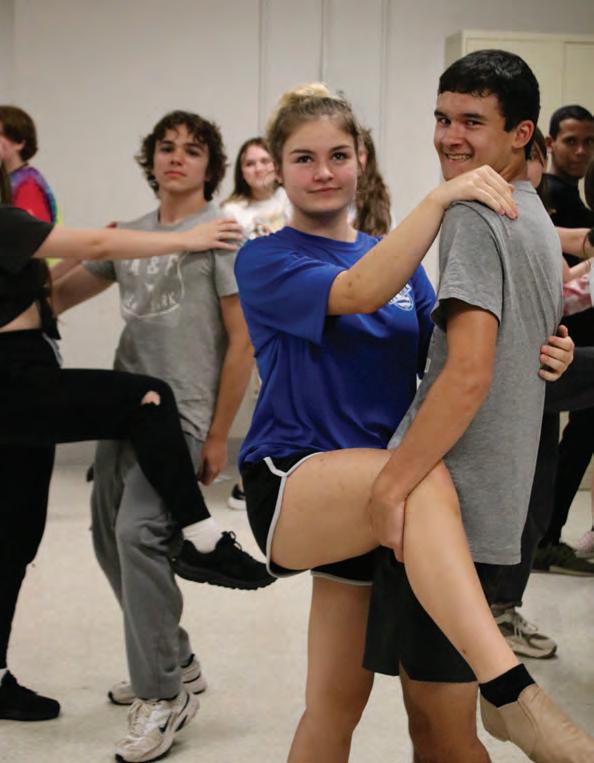
the Manhattan Rhythm Kings, we sat in that same living room and made a list of people we’d love to work with. Tommy Tune was at the top of the list. He was at that time performing on Broadway in “My One and Only,” another Gershwin musical. We had these cute little press kits we put together. We put a press kit and a letter to Mr. Tune at the stage door. We didn’t hear anything for a while. Then, the story goes — as was told back to us — he had a party in his beautiful penthouse apartment and somebody put our cassette on, playing our version of The Jitterbug. He said he looked up and all of a sudden everybody in the room was doing this [waving their arms and moving to the music]. He asked, ‘Who are these guys?’”
More networking was about to take place.
“A mutual friend, Larry Taylor, was aware of this treasure trove of songs that Fred Astaire wrote — nobody knew he wrote songs, but he did and he had a trunkful of them. Some were horrible. But there were 12 or so that Taylor told Tommy, ‘You should put an act together with these songs.” And Tommy said, ‘Get those
guys, the Manhattan Rhythm Kings and I will. If they want to do it, I’ll do it.’”
“That’s what started our relationship,” Hanson said.
“We worked with Tommy for a month in Chicago, then we’d go do concerts on our own, doing onenighters, driving to every city in America in our van with a kitchen bag in the back seat so we could cook in the hotel room because you never knew what kind of food you’d find on the road.”
Chita Rivera split a bill with the Kings. They opened for Dom DeLuise in Atlantic City. And they were doing a lot of traveling.
“I got itchy,” Hanson explained. “I was finally getting tired of doing the same material for 15 years.”
He took a role in the revival of “Kiss Me Kate” in 2001 after doing his last 10 shows for the Kings in Florida.
Then 9/11 happened and New York City shut down.
“We made it to the end of the year because our cast devised a plan to save the show,” he said. “Our leading

Courtney Larkin, the director and choreographer of OFC (Opportunities for Creativity) Creations Theatre's summer camp musical, goes over notes with musical director Tripp Hanson, who has made the trip from Broadway to Rochester and Brighton. The group was working on the play “The Wedding Singer.”
lady, Carolee Carmello and our lead electrician hatched a plan and the cast and crew donated 75% of our salaries to the box office. We gave tickets away to FEMA workers and people who were stuck in the city, people who had losses or were traumatized — just giving tickets away to keep the theater going.”
He was chosen as a speed tapdancer for “Thoroughly Modern Millie,” but the theater was wearing on him.
“I’m 47 years old and I’m realizing it’s getting harder, physically, to do eight shows a week,” he said.
He decided to go for his master’s degree in acupuncture.
Acupuncture? Why?
“Because it helped me so much,” Hanson explained. “And it also helped my dog. To be honest, my first impulse was to become an animal acupuncturist. But then I found out you have to be a veterinarian to perform acupuncture on animals.”
In school during the day and being in a show for three and a half years, “writing term papers in my T-shirt at my dressing station,” he got his degree in 2007. “The Drowsey Chaperone” was playing on Broadway and he got the call to join in. That’s where he started his acupuncture practice —
treating castmates.
Hanson enjoyed it.
“I was pretty good at it,” he said. Finally, he started his own private practice and got busy.
But running a business in the city cost $12,000 a month. That, plus all the paperwork and insurance issues, broke him down.
“I got burned out,” he said.
With his savings dwindling, Hanson came home to husband, David, and said: “Your turn, you gotta go to work.”
David accepted a call from a United Church of Christ in Tiburon, California, and off they went for five years.
During that period, Hanson became certified in neuro coaching and began another business venture, a mindfulness practice based on neuroscience processes, helping people get unstuck.
Then COVID-19 hit.
“We suddenly felt stuck,” Hanson said.
There were family tragedies with COVID and other illnesses. He and David went from two grandkids to four. They wanted to get back to family on the East Coast and David was fond of Rochester. David made some contacts and got a call from the United
Church of Christ in Webster.
Once back in the area, Hanson, now also looking at doing something though he had retired, used some of David’s new contacts to get a lead.
“Someone was looking for a voice teacher in a theater in Brighton,” he explained. “I said, ‘Wherever that is, hook me up.’”
He ended up quickly talking to Hadley Strelau, a vocal teacher at OFC Creations Theatre Center.
“She said, ‘Come over. When can we meet?’ “I told her I don’t have any furniture and don’t have many changes of clothing. She said, ’I don’t care. Put on your shorts and come over.’ I was introduced to executive director Eric Johnson and I was really impressed with what I saw,” he said.
And he joined up. Now he teaches vocal and dance students and has returned to the stage after a 15-year absence.
He’ll be in the OTC upcoming productions of “Boy from Oz” (Sept. 12-29), “West Side Story” (in October), “Gypsy” (January-February) and “Anything Goes” (April).
He’s also the tap captain for the first show. OFC has two other shows on tap this year, “The Prince of Egypt” (from the Disney cartoon, in December) and “Jersey Boys” (May).
The ambitious show schedule includes Broadway, movie and television stars as the OTC Creations Theatre Center ups the ante in bringing professional talent to the area.
Hanson, who hadn’t had a speaking role on stage in 15 years, came back to the floodlights himself in February for “The Producers.”
He’s found himself again in Rochester. And he’s got a sharper sense to his calling.
“That’s the thing about creativity — you can’t get it to one place and say ‘This is what I do, this is how I do it, don’t ask me any questions.’ That’s not today’s world. All of us on the stage, we’re always asking, ‘What else can I do? How else can I grow?’ In teaching kids, I want them to know this creativity is a lifelong process. That requires me to be stepping into my own unknown and be willing to put myself on that same line that I’m asking them to put themselves on,” he said.



Whether making �inal arrangements for yourself or making decisions for a loved one who recently passed away, you will �ind White Haven Memorial Park’s sta�f o�fers kindness and understanding. We o�fer in-ground, mausoleum and niche burial proper�y, a beautiful Nature Trail for cremains as well as a Green Burial option. Our two chapels are available and are a per�ect place for hosting a memorial service. One of our Memorial Counselors can guide you through the process.



modern
By Deborah Jeanne Sergeant
Ken and Judy Scott of Webster first learned of Garth Fagan Dance in Rochester when taking their young children to dance lessons.
Eventually, they decided to join in and take lessons.
Twenty-four years later the couple still take modern dance lessons at Garth Fagan under the tutelage of owner Natalie Rogers-Cropper, who is also the executive director and president of the school.
Ken Scott said that the experience has helped them stay moving, despite
being in their late 60s. With the exception of recovery from a bone spur procedure for Ken, they’ve been dancing through their retirement.
Scott said that when he has encouraged some adult friends to join him, they express apprehension about joining a dance school. Suppose they couldn’t keep up? Or what if they couldn’t remember the right moves?
“This is one of the few endeavors in your life where you can participate and you’re never judged by the instructor or the other participants,” Scott said. He also likes the exercise aspects
of the class. After stretching for about 20 minutes, the rest of the 45-minute class is more active movement.
“It’s a way to keep moving and keep things relatively flexible,” he said. “I don’t want to be someone who grows older and dodders around because they can’t move so well anymore.”
He has also developed lifelong friendships with people he has known through Garth Fagan Dance.
“I’m 62 and still dancing; that speaks volumes,” said Rogers-Cropper.
She attributes that in part to the
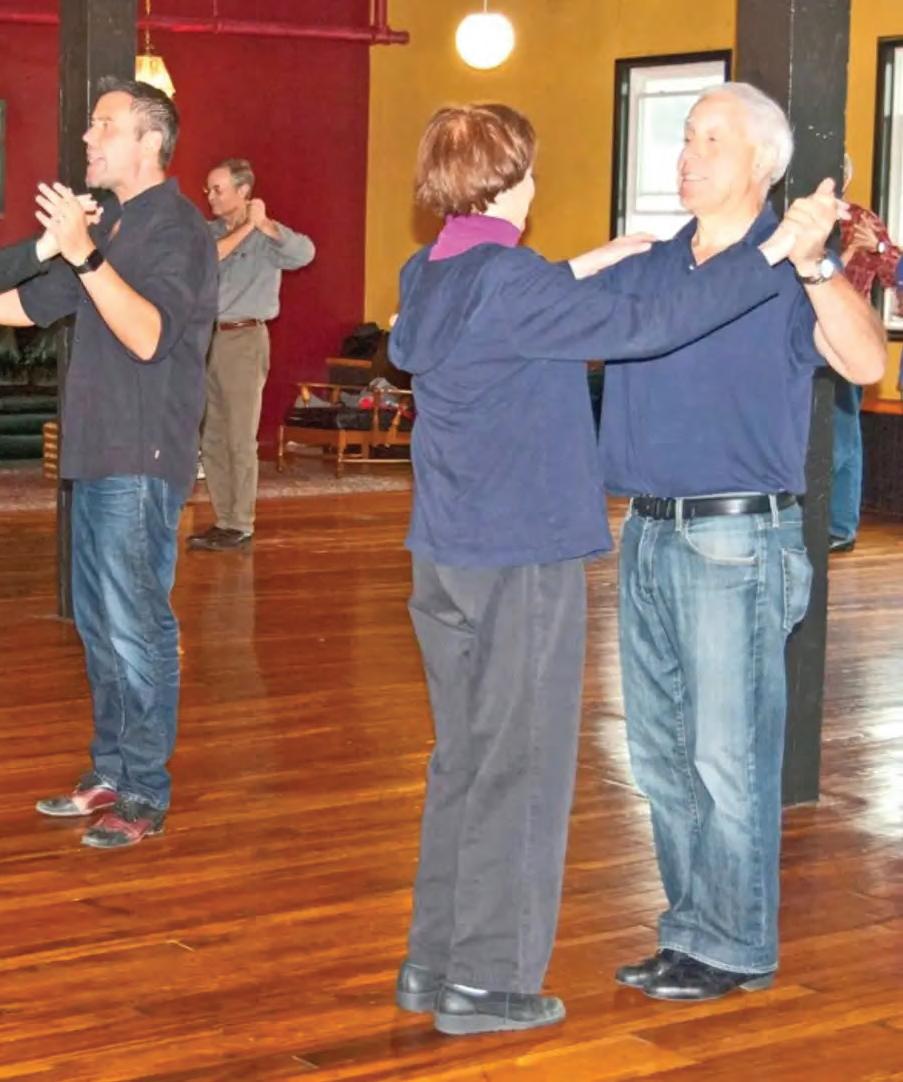
Garth Fagan technique which she said is designed to protect the dancer and build strength and flexibility. Some of her students are in their 70s and dislike going to a gym for fitness. Although not a style of dance that would lend toward dancing at a wedding or other event, modern dance is often seen on stage and Rogers-Cropper said that some of her students perform on stage.
At Rochester Dance Lessons in Rochester, owner Jay Ruest said that her school attracts some retirees because they’re trying to find productive ways to spend their newfound time and they have more financial resources now that the children have grown and flown.
“They’re mostly couples, although I have a few single women,” Ruest said.
The school teaches ballroom dancing with a partner and includes dance styles such as salsa, tango,
bolero, cha cha, hustle, Lindy hop, mambo, rumba, swing, foxtrot, and waltz. The school hosts events monthly and goes out on the town to practice.
“When people start to learn, everyone progresses,” Ruest said. “They all get better, though some not as quickly as they’d like to. It’s fun to see that progress. It’s rewarding to see people learn a new step and get to the end. It’s like a game and you can see people get excited to get to that next step, that next level.”
Learning together creates tight bonds among students. Sometimes, Ruest and students take a cruise together and share experiences beyond dancing.
“A lot of students will come up and say, ‘Do you realize it’s been eight years?’” Ruest said.





The Port City is rich in history — and plenty of different foods
By Chris Clemens


Any leaf peeper knows the trees in New York start to turn soonest in the Adirondacks.
From there colors creep outward in all directions until eventually the Empire State is a gorgeous landscape of yellows, reds and oranges.
Oswego isn’t in the Aidrondacks — but because of its proximity, you’ll typically see changing colors here a little sooner than you might in regions further south.
This fall get a head start on your foliage tour and checkout the Port City of Central New York.
As a port city, Oswego’s shipping history goes back centuries. This stopoff in Lake Ontario meant merchant ships could deliver goods to regions in New York that weren’t otherwise as accessible from ports in New York City. As a result, the city’s relationship to the shipping industry and its maritime culture runs deep.
The H. Lee White Maritime Museum sits properly on the edge of the water and offers a glimpse into the long history of Oswego’s shipping industry. Here at the museum, you can also take a boat ride, about one mile, out to the historic West Pierhead Lighthouse, known locally as the Oswego Lighthouse. For many years the lighthouse wasn’t open to the public. But now it’s one of the most unique tours you’ll find in the region.
The city’s position on the water didn’t just give it a legup with commerce, but also with national security. The stories of U.S. military battles fought on these shores are

retold through historical exhibits at Fort Ontario State Park. The star-shaped fort is now a New York state historic site and offers an opportunity to walk through an important piece of the state’s history. Visitors to the park might also be surprised to learn that the land adjacent was the site of the only place in the country to house Jewish refugees during World War II. The Safe Haven Museum is walking distance from the fort and tells the story of those brought here from other countries seeking refuge and safety. Even the most casual of history buffs will appreciate that there’s no other place like it in the country.
The water systems in Oswego haven’t just been used for commerce and war. There’s also a burgeoning recreational boating scene here. Marinas on the lake give locals access to the Great Lakes. Plus, visitors by
boat can step off the dock and be walking distance to the downtown area.
In 2023, Oswego became the first city in the state to complete its Downtown Revitalization Initiative. Years earlier the Governor’s office in Albany awarded a number of improvement grants to different municipalities and each set out to use those funds to reinvent their communities.
Oswego’s efforts gained special recognition for not only completing the projects sooner than other cities, but for creating improvements that impact visitors in addition to the local residents. While you’re completing your tour of the water’s edge, be sure to visit the new River Walk. The modern upgrades to the public park really give visitors an opportunity to view Lake Ontario in ways you won’t find in
other parts of the state.
The Downtown Revitalization Initiative also gave the city a shot at revitalizing their city center. A brand new Water Street Pocket Park — between Water Street and West First Street — now hosts regular live music events and a chance to sit and enjoy the city. The park is surrounded by views of downtown that blend historic legacy and modern upgrades.
Anyone who has been to Oswego in the past and is revisiting now will likely catch themselves noting how much has changed in this section of the city.
The construction of buildings like the Litatro right on the river have given the landscape a fresh makeover. On the top floor of Litatro you’ll find the Rooftop Lounge with fine dining and a view of the city like no other restaurant can offer. A few doors up, the Red Sun

A view of downtown Oswego.
Fort Ontario State Park: The star-shaped fort is now a New York state historic site and offers an opportunity to walk through an important piece of the state’s history.
Fire Roasting Co. provides a more casual atmosphere with an elevated menu highlighting its wood-fired oven.
For a super casual breakfast, Wade’s Diner is a veteran gem on the eastside featuring classic diner favorites like eggs and pancakes. Locals know the food here is fantastic, but they also know the quirky history with this spot. The original diner was housed in a Pullman train car when it opened in 1937. When Neal Wade purchased the train car to open his diner, he hadn’t gotten a proper permit to bring it into town. Instead of dealing with the bureaucratic red tape of procuring a permit, he and a few friends moved the car into place in the middle of the night when no one was paying attention. The next day everyone couldn’t believe their eyes when a Pullman train car was sitting at the side of the road and no one could (or would) explain how

it got there. With no evidence of how it arrived, there was no scapegoat to issue a ticket to. History was made with the founding of Wade’s and since then the survival of a fire, multiple owners and nearly a century of great food they’re still continuing to make history.
If you’re just looking for a quick snack, Oswego has also been incredibly supportive to small businesses with a niche offering. Heidi Ho Donuts just up the road from Wade’s is a small woman-owned bakery that offers doughnuts that go way above and beyond. River Walk Coffee Roasters is just a few doors up from the pocket park and its own coffee roasts bring a big-city specialty coffee flare to the small urban community here.
Further west near SUNY Oswego is Rudy’s, which is practically famous for its hot dog and fries style menu.
Plus, any Oswego local will tell you that the shoreline next to Rudy’s is the best place in all of Lake Ontario to catch a sunset.
Whether it’s a small specialty doughnut shop or high-end rooftop dining, there’s a wide range of offerings in Oswego that will appeal to any palate. With museums, waterside recreation, festivals and plenty more, Oswego has plenty of reasons to visit.

Chris Clemens was born, raised and still lives in Rochester. With a penchant for exploring his own backyard, he has used words and digital media to tell the stories of Upstate New York that he’s discovered on the road.

By John Addyman Email: john.addyman@yahoo.com

I’m getting to the part of my life where I’m asking, “Is this an age thing or a guy thing or a 315 area code thing or a marriage relationship thing?”
Maybe you can help me decide. Maybe you have some wisdom to share.
Here’s the situation. My wife and I are going to the store. I look at my watch and I say, “We have to get going in the next five minutes.”
She says, “OK. I’m working on it.”
Five minutes pass.
“We have to go,” I say.
“You’re right: I have to go the bathroom.”
Minutes later… “Honey, we’re going to be late.”
“I have the wrong shoes on.”
“The store will be closed before we get there.”
“No, it won’t. You always do this.”
“We really are late.”
“Just let me put my shoes on.”
“Where are they? I don’t see them.”
“They’re upstairs.”
“Please go get them.”
She stops in the middle of the
steps, turns and tells me: “I also need to get the reusable bags out of my car.”
“No, you don’t, I already put them into my car. Let’s go.”
“Did you get my favorite bags?”
“I got four bags. I’m sure several of them are your favorites.”
“We need to take the blue one — it’s for frozen foods.”
“It’s getting dark. The street lights are starting to turn on.”
“Did you get the blue bag?”
“I don’t remember. We have to go. I’m going to go out and start the car and back slowly down the driveway.”
“Really? Are you going to make me run after the car?”
“No. You can catch up with a spirited walk. You’re going to get the correct shoes for that, right?”
And out the door I went. I started the car and gunned the engine a couple of times. Vroom, Vroom!! I wanted her to know that I was serious about leaving.
The back door didn’t open. She might have gone to the bathroom again. I beeped the horn a couple of times. The door stayed closed.
“I give up,” I said to myself and I
shut off the car. And I sat for a couple of minutes. What was she doing?
Time for me to get out and go to the back door and see what was happening. I opened the door.
“Why are you standing there?” she asked. “I thought we had to go.”
“I’m trying to find out why we’re still here when we were on our way to the store a couple of hours ago.”
She looked at me like I had two heads.
“I’m ready,” she said. “Let’s do it.”
And she stood up from the kitchen table, bags in her arms and her purse over her shoulder.
“Do you have your phone?” I asked, just trying to eliminate another potential delay.
“Of course.”
“Your wallet?”
“Sure.” She was walking toward me.
I looked at her, expectantly. “Got everything?”
“Of course.”
Holding the door open for her as we walked down the back steps, I asked, “What took you so long? I thought you were ready.”
“I got a call from my sister.”
“What did she want?”
“She was walking out the door while her husband was waiting for her in the car.”
“What took her so long?”
“She had to get her shoes, her purse, her bags, her keys, her wallet, her eye drops, her grocery list…”
That stopped me in my tracks. I put my hand on my wife’s arm to slow her down and asked a question I really didn’t want the answer for.
“Do you have your grocery list?”
My wife gave me a quizzical look. She was thinking. Cars passed our house out on the street. Birds were chirping. We could hear a plane overhead. The breeze was rustling the leaves. The universe started to grind to a halt. I said to myself, “Oh, no…”
And now my sweet wife’s face changed. She put her hand on my arm, gave me a little pat and pivoted on the steps. She pursed her lips.
“No,” she said.
Then she gave me a kiss, poked me softly on the chest and smiled…and skipped quickly back into the house.
I got back into the car and said to myself, “Does anybody else go to the store like this?”









By Melody Burri

Duane Pancoast has published a new book on gardening, “The Geriatric Gardener 2.0: MORE Adaptive Gardening Advice For Seniors.” This and his previous book, “The Geriatric Gardener,” are available at https:// thepancoastconcern.com.
Q: You’ve enjoyed a long, prolific career in broadcasting and public relations. What are experiences that have brought you the most joy and satisfaction?
A: “For years I specialized in representing the green industry, including T ed Collins Tree & Landscape, Bir chcrest Tree & Landscape, and other tree and landscape companies and associations across the country. As it turned out, my college career in landscape architecture and degree in radio and television paid off. They enabled me to hit the ground running and take clients from small growing companies to the top of the industry. Particularly rewarding was the 1985 launch of my own public
relations firm, The Pancoast Concern, which I headed for 38 years before retiring in 2023. My son now carries on the tradition with TPC Marketing, Inc.”
Q: Retirement and the aging process have impacted your passion for gardening — tell us about that.
A: “The changes have happened over time, as they do for many. One of my knees went out around 2000, which made lawn mowing more difficult and meant I could no longer kneel to plant or weed. Then I had a stroke in 2020 which changed things even more. Now I hire someone to help with lawn, weeding and pruning maintenance. That leaves me free to concentrate on
writing and tend my indoor garden — I’ve got about 30 tillandsia, or air plants. I also do talks and seminars for garden clubs and associations, master gardener groups and senior citizen groups. ”
Q: You’ve now published two books and maintain a blog on the subject of “adaptive gardening.” What does that mean and what kinds of tips can readers learn?
A: “It’s a term that means adapting your garden and your gardening to changing physical capabilities as you age. There’s more than one reason why people have to adapt — it’s not all about muscles and joints. There are also cardio and respiratory issues, deteriorating vision, temperature sensitivities and memory loss. These all need to be addressed in a different way.
“Adaptive gardening is such a new and evolving discipline, so what I wrote in 2020 is still pertinent, but there are many new developments. In the first book I was pushing container gardening and raised beds. Now I’m also interested in vertical gardens and elevated beds (raised beds with legs) that will accommodate wheelchairs. I previously talked about downsizing your gardens when you move to a smaller place. Now I talk about ‘downsizing in place.’ And my next blog post describes a way you can help your annuals reseed for the following year.”
Q: What do you hope readers will learn from reading your blog and books?
A: “Nobody has to be a retired gardener, you simply have to adapt to your changing physical capabilities. Aging happens in stages and the changes you make now can lessen or eliminate future challenges.
“So now may actually be the right time to make your patio smoother and your paths wider to accommodate a walker or wheelchair. Taking care of your knees now can minimize future wear and tear. Wearing a brimmed hat might help you avoid sun damage. And lifting with your legs instead of your back will surely have future benefits.
“Know that even if you’re at the “age of invincibility,” that will change. You can slow down the process or even head off problems by following these and other adaptive gardening tips.”

